Physiotherapy Service
Physiotherapy Service
Stroke Rehabilitation: Conditions and SymptomsOrthopedic rehabilitation is a specialized branch of physiotherapy aimed at restoring function, strength, and mobility after musculoskeletal injuries, surgeries, or chronic orthopedic conditions. It plays a crucial role in helping patients recover from bone, joint, ligament, and muscle-related issues, ensuring improved quality of life and independence.
Common Conditions Treated:
- Post-fracture rehabilitation
- Post joint replacement surgeries (knee, hip, shoulder)
- Ligament injuries (e.g., ACL, MCL tears)
- Sports injuries (strains, sprains, dislocations)
- Arthritis (osteoarthritis, rheumatoid arthritis)
- Spine disorders (spondylosis, disc herniation)
- Tendonitis and bursitis
- Frozen shoulder
- Post-casting stiffness or weakness
Key Symptoms That Require Ortho Rehab:
Pain and Inflammation:
- Persistent joint or muscle pain
- Swelling around affected areas
Mobility Issues:
- Limited range of motion
- Difficulty in walking, climbing stairs, or performing daily tasks
Muscle Weakness:
- Loss of strength in limbs or joints
- Fatigue with simple movements
Post-Surgical Symptoms:
- Stiffness or scar tissue formation
- Weakness after immobilization (like casting or bed rest)
Functional Limitations:
- Inability to return to sports or work
- Poor coordination and balance
Orthopedic rehabilitation is essential for individuals recovering from injuries, surgeries, or chronic conditions affecting bones and joints. Whether it’s regaining mobility after a knee replacement or building strength following a fracture, orthopedic physiotherapy helps reduce pain, restore function, and prevent long-term disability. Symptoms such as joint stiffness, muscle weakness, limited mobility, and chronic pain indicate the need for professional rehab. A personalized treatment plan—including exercises, manual therapy, pain relief techniques, and functional training—is key to a successful recovery and a return to active life.
Neurological rehabilitation (Neuro Rehab) is a comprehensive physiotherapy program designed to help individuals recover and regain function after damage to the nervous system. It plays a vital role in improving mobility, strength, coordination, and independence in patients affected by neurological conditions such as stroke, spinal cord injuries, Parkinson’s disease, multiple sclerosis, and cerebral palsy.
Common Neurological Conditions Treated:
- Stroke (Ischemic or Hemorrhagic)
- Spinal Cord Injuries
- Parkinson’s Disease
- Multiple Sclerosis
- Cerebral Palsy
- Traumatic Brain Injuries (TBI)
- Peripheral Neuropathy
- Bell’s Palsy
- Guillain-Barré Syndrome
- Motor Neuron Disease
Key Symptoms Requiring Neuro Rehabilitation:
Motor Deficits:
- Weakness or paralysis of limbs
- Inability to walk or maintain balance
- Loss of coordination and fine motor skills
Sensory Disturbances:
- Numbness or tingling in arms or legs
- Hypersensitivity to touch or temperature
Cognitive & Speech Issues:
- Memory loss or confusion
- Difficulty in speaking or understanding language (aphasia)
Spasticity & Muscle Stiffness:
- Increased muscle tone
- Difficulty in performing smooth movements
Postural & Gait Abnormalities:
- Stooped posture
- Shuffling walk or foot drop
Neuro rehabilitation focuses on helping individuals recover after damage to the brain, spinal cord, or peripheral nerves. It aims to restore movement, strength, balance, and coordination that may be affected due to neurological disorders. Patients often experience muscle weakness, loss of mobility, speech difficulties, or coordination issues. A structured rehab plan includes physiotherapy, balance training, strength exercises, neuromuscular re-education, and functional task training. With regular sessions and professional guidance, patients can regain independence, improve their daily functioning, and enhance their overall quality of life. Early intervention is key to maximizing recovery in neuro rehab.
Cardiac (or cardio) rehabilitation is a medically supervised program aimed at improving cardiovascular health after a heart-related event or diagnosis. It combines exercise training, lifestyle education, and emotional support to help individuals recover and reduce the risk of future heart problems.
Common Conditions Requiring Cardiac Rehabilitation:
- Heart attack (Myocardial Infarction)
- Coronary artery disease (CAD)
- Angina (chest pain)
- Heart failure
- Post-coronary artery bypass graft (CABG) surgery
- Post-angioplasty or stent placement
- Cardiomyopathy
- Heart valve surgery
- Heart transplant recovery
Symptoms That Indicate Need for Cardiac Rehab:
Physical Symptoms:
- Shortness of breath with minimal exertion
- Chest pain or tightness (angina)
- Fatigue and low energy levels
- Swelling in legs and ankles (edema)
- Rapid or irregular heartbeat (palpitations)
- Dizziness or fainting spells
Exercise Intolerance:
- Inability to walk moderate distances
- Low stamina or endurance
- Breathlessness during daily activities
Psychological Symptoms:
- Anxiety or fear of another heart event
- Depression or mood swings
- Low confidence in physical abilities
Cardiac rehabilitation is essential for patients recovering from heart attacks, surgeries, or chronic heart diseases. It focuses on improving cardiovascular strength, reducing symptoms like fatigue, chest discomfort, and breathlessness, and preventing future cardiac events. Common signs that indicate the need for rehab include shortness of breath during mild activity, swelling in the legs, chest pain, and low energy. The program involves tailored physical activity, heart-healthy education, and stress management strategies. It empowers patients to safely regain strength, boost endurance, and adopt lifelong habits for heart health. With timely rehab and expert supervision, patients enjoy better recovery and reduced risk of complications.
Pulmonary rehabilitation is a structured program designed to help individuals with chronic lung diseases improve their quality of life and physical functioning. It addresses both the physical and psychological challenges of respiratory conditions, providing patients with the tools to manage their symptoms effectively.
Conditions Treated with Pulmonary Rehabilitation:
- Chronic Obstructive Pulmonary Disease (COPD)
- Emphysema
- Chronic Bronchitis
- Pulmonary Fibrosis
- Asthma (severe cases)
- Cystic Fibrosis
- Interstitial Lung Disease (ILD)
- Acute Respiratory Distress Syndrome (ARDS)
- Pulmonary Hypertension
- Sleep Apnea (associated with daytime fatigue)
- Post-surgical recovery (lung transplant, thoracic surgery)
- Lung Cancer (post-treatment rehabilitation)
- Sarcoidosis
- Obesity Hypoventilation Syndrome (OHS)
- Bronchiectasis
Symptoms Addressed by Pulmonary Rehabilitation:
- Shortness of Breath (Dyspnea) – Difficulty breathing, especially during physical exertion.
- Chronic Cough – Persistent coughing, often productive of mucus.
- Fatigue – Overwhelming tiredness and lack of energy.
- Wheezing – High-pitched sound while breathing due to narrowed airways.
- Chest Tightness – A feeling of pressure or constriction in the chest.
- Cyanosis – Bluish discoloration of the lips or extremities due to low oxygen levels.
- Increased Mucus Production – Excessive sputum, leading to blocked airways.
- Recurrent Respiratory Infections – Increased frequency of pneumonia, bronchitis, or colds.
- Limited Physical Endurance – Reduced stamina and difficulty performing physical activities.
- Difficulty Sleeping – Sleep disturbances due to breathing difficulties or discomfort.
- Anxiety – Feelings of stress or fear associated with breathing difficulties.
- Depression – Emotional challenges from chronic illness and limited physical activity.
- Loss of Appetite – Reduced desire to eat due to breathlessness and fatigue.
- Swelling in the Legs – Due to fluid retention from pulmonary or heart problems.
- Memory and Concentration Issues – Cognitive difficulties related to chronic low oxygen levels.
Pulmonary rehabilitation plays a vital role in improving the symptoms of these conditions by combining physical exercises, breathing techniques, education, and emotional support. This approach helps patients gain better control over their illness and enhances their overall health.
Stroke rehabilitation is a crucial part of the recovery process for individuals who have experienced a stroke. It focuses on helping patients regain lost abilities and develop new strategies for managing daily activities. Stroke rehabilitation addresses both the physical and cognitive aspects of recovery, aiming to improve the quality of life and enhance independence.
Conditions Treated in Stroke Rehabilitation:
- Ischemic Stroke – Caused by a blockage in a blood vessel supplying the brain.
- Hemorrhagic Stroke – Results from a ruptured blood vessel in the brain.
- Transient Ischemic Attack (TIA) – A temporary blockage in the brain’s blood supply, often referred to as a mini-stroke.
- Cerebral Venous Thrombosis (CVT) – A rare condition caused by a blood clot in the veins of the brain.
- Brainstem Stroke – A stroke occurring in the brainstem, affecting vital functions such as breathing and heart rate.
- Post-Stroke Spasticity – Muscle tightness or stiffness following a stroke, often impacting movement.
- Post-Stroke Aphasia – Difficulty in speaking, understanding, reading, or writing due to damage in the language-processing areas of the brain.
- Ataxia – Loss of muscle coordination, often affecting balance and movement.
- Hemianopia – Loss of vision in half of the visual field, often resulting from a stroke.
- Post-Stroke Depression – Emotional challenges such as sadness, anxiety, and a feeling of hopelessness that can occur after a stroke.
Symptoms Addressed by Stroke Rehabilitation:
Paralysis or Weakness – Loss of strength or movement, typically on one side of the body (hemiplegia).
Difficulty Walking – Impaired mobility or trouble maintaining balance.
Speech Impairment (Aphasia) – Difficulty in forming or understanding speech.
Memory Loss – Trouble recalling information or performing tasks that require cognitive recall.
Fatigue – Extreme tiredness that interferes with daily activities.
Pain or Discomfort – Chronic pain in limbs or muscles affected by the stroke.
Loss of Coordination – Difficulty with fine motor skills or performing precise movements.
Vision Problems – Blurred vision or loss of part of the visual field (hemianopia).
Emotional Instability – Mood swings, anxiety, or depression due to the impact of stroke.
Difficulty Swallowing (Dysphagia) – Trouble swallowing food or liquids, increasing the risk of choking or aspiration.
Stroke rehabilitation combines physical therapy, occupational therapy, speech therapy, and psychological support to address these conditions and symptoms. The goal is to maximize recovery, promote independence, and improve the patient’s overall well-being.
Special Education refers to tailored instructional programs designed to meet the unique learning needs of children with developmental, intellectual, physical, emotional, or behavioral challenges. It provides structured learning with appropriate resources, accommodations, and therapeutic support to help every child reach their full academic and social potential.
Conditions Commonly Supported in Special Education:
- Autism Spectrum Disorder (ASD)
- Attention-Deficit/Hyperactivity Disorder (ADHD)
- Down Syndrome
- Learning Disabilities (Dyslexia, Dyscalculia, Dysgraphia)
- Cerebral Palsy
- Intellectual Disabilities
- Hearing Impairment
- Visual Impairment
- Emotional and Behavioral Disorders
- Speech and Language Disorders
Symptoms That Indicate the Need for Special Education:
- Delayed Speech or Communication Skills
- Difficulty in Reading, Writing, or Math
- Short Attention Span or Inattentiveness
- Poor Memory or Retention Skills
- Difficulty Following Instructions
- Frequent Tantrums or Behavioral Outbursts
- Challenges in Social Interaction or Peer Play
- Unusual Repetitive Behaviors or Movements
- Difficulty with Fine or Gross Motor Skills
- Lack of Progress in Regular Classroom Settings
Special education programs are crafted through Individualized Education Plans (IEPs), created by a team of educators, therapists, and parents. These plans include specialized teaching strategies, assistive technology, and therapies such as occupational, speech, or behavioral interventions. The goal is to empower children with challenges to achieve academic success and build confidence in a supportive, inclusive environment tailored to their specific learning styles and needs.
Speech Therapy is a specialized intervention designed to diagnose and treat communication disorders, speech impediments, and oral motor difficulties. It helps individuals of all ages improve their speech clarity, language comprehension, voice modulation, and swallowing functions.
Conditions Treated by Speech Therapy:
- Speech Delay
- Autism Spectrum Disorder (ASD)
- Stuttering (Fluency Disorder)
- Cerebral Palsy
- Aphasia (Post-Stroke Language Loss)
- Down Syndrome
- Apraxia of Speech
- Hearing Impairment
- Cleft Lip and Palate
- Traumatic Brain Injury (TBI)
Symptoms Indicating the Need for Speech Therapy:
- Delayed Speech Development
- Difficulty Pronouncing Words Clearly
- Limited Vocabulary for Age
- Struggles to Form Sentences
- Stammering or Stuttering
- Inability to Follow Verbal Instructions
- Slurred or Unclear Speech
- Hoarse or Raspy Voice
- Difficulty Swallowing (Dysphagia)
- Poor Social Communication Skills
Speech therapy typically begins with a detailed assessment to identify the individual’s communication challenges. Based on the diagnosis, a personalized therapy plan is created. Sessions may involve exercises to strengthen the muscles used in speech, activities to improve language comprehension, or the use of assistive devices. For children, therapy often includes play-based techniques, while adults may focus on regaining speech post-injury or illness. The ultimate goal is to enhance communication, boost confidence, and support better integration in academic, social, and professional settings.
Occupational Therapy (OT) is a holistic approach that helps individuals of all ages participate in meaningful daily activities (occupations) despite physical, cognitive, or emotional challenges. The aim is to promote independence, improve functional skills, and enhance quality of life.
Conditions Treated by Occupational Therapy:
- Cerebral Palsy
- Autism Spectrum Disorder (ASD)
- Stroke Recovery
- Arthritis
- Traumatic Brain Injury (TBI)
- Sensory Processing Disorder
- Parkinson’s Disease
- Down Syndrome
- Developmental Delays
- Spinal Cord Injury
Symptoms Indicating the Need for Occupational Therapy:
- Difficulty with Fine Motor Skills (e.g., writing, buttoning clothes)
- Challenges in Daily Self-Care Tasks (e.g., dressing, grooming)
- Poor Hand-Eye Coordination
- Delayed Motor Milestones in Children
- Difficulty Managing Emotions or Behaviors
- Problems with Sensory Integration (over- or under-reactivity)
- Poor Balance and Coordination
- Limited Social Interaction Skills
- Fatigue During Routine Activities
- Reduced Independence After Injury or Surgery
Occupational therapists assess a person’s physical, emotional, and environmental challenges to develop personalized intervention plans. These may include exercises to improve motor control, adaptive techniques for daily living, assistive devices, and strategies for better sensory regulation or cognitive functioning. OT empowers individuals to lead more independent and fulfilling lives by addressing the functional barriers that affect their ability to work, learn, play, or care for themselves and others.
Manual Therapy is a hands-on physiotherapy technique involving the manipulation and mobilization of muscles, joints, and soft tissues. It is primarily used to reduce pain, restore mobility, improve circulation, and aid recovery from injuries.
Conditions Treated by Manual Therapy:
- Back Pain (including lower back pain)
- Neck Pain
- Frozen Shoulder
- Tennis Elbow
- Sciatica
- Joint Stiffness
- Sports Injuries
- Post-surgical Joint Pain
- Arthritis
- Muscle Spasms or Tightness
Symptoms Indicating the Need for Manual Therapy:
- Chronic or Acute Muscular Pain
- Reduced Range of Motion
- Joint Stiffness or Locking
- Swelling or Inflammation Around Joints
- Numbness or Tingling Sensation
- Muscle Weakness
- Pain While Moving or Bending
- Muscle Imbalance or Postural Issues
- Difficulty in Daily Physical Activities
- Recurring Headaches Due to Muscle Tension
Manual therapy begins with a detailed assessment by a trained physiotherapist to identify the root cause of pain or dysfunction. Techniques like joint mobilization, soft tissue massage, myofascial release, and trigger point therapy are then applied to target the affected areas. This therapy enhances blood flow, reduces muscle tightness, and improves flexibility. Often used in conjunction with exercise and rehabilitation programs, manual therapy offers relief without medication or invasive procedures. It plays a crucial role in enhancing movement, restoring strength, and accelerating recovery in both acute and chronic musculoskeletal conditions.
Taping is a supportive technique used in physiotherapy and sports medicine to stabilize joints, support muscles, relieve pain, and prevent injury. It involves applying adhesive tape (rigid or elastic) to specific body parts to aid in movement, reduce strain, and facilitate healing.
Conditions Treated with Taping:
- Ankle Sprain
- Knee Ligament Injury (ACL/MCL sprain)
- Tennis Elbow (Lateral Epicondylitis)
- Shoulder Impingement
- Shin Splints
- Patellofemoral Pain Syndrome
- Achilles Tendinitis
- Lower Back Pain
- Plantar Fasciitis
- Carpal Tunnel Syndrome
Symptoms Indicating the Use of Taping:
- Joint Instability
- Muscle Weakness
- Localized Swelling
- Sharp or Persistent Pain During Movement
- Recurrent Sports Injuries
- Poor Posture or Alignment
- Tingling or Numbness in Limbs
- Muscle Fatigue After Minimal Activity
- Restricted Range of Motion
- Feeling of Joint “Giving Way”
Taping techniques, such as Kinesio taping or rigid sports taping, provide structural support to injured or vulnerable areas while still allowing a degree of movement. Taping helps offload stress from tendons and ligaments, reduces inflammation, and improves proprioception (the sense of joint position). It is commonly used in athletes but is equally effective for non-athletic individuals dealing with musculoskeletal issues. A trained physiotherapist applies the tape with precision based on the injury’s nature, promoting faster recovery and safer movement.
Joint mobilization is a manual therapy technique used by physiotherapists to improve joint function, reduce pain, and increase the range of motion. It involves passive movements applied at various speeds and amplitudes to the joints, helping restore their normal movement patterns.
Conditions Treated with Joint Mobilization:
- Frozen Shoulder (Adhesive Capsulitis)
- Knee Osteoarthritis
- Cervical Spondylosis
- Lumbar Spondylosis
- Ankle Stiffness Post-Sprain
- Post-Fracture Joint Stiffness
- Hip Arthritis
- Wrist or Hand Stiffness
- Post-Operative Joint Immobilization
- Rheumatoid Arthritis (in remission phase)
Symptoms Indicating the Need for Joint Mobilization:
- Joint Stiffness
- Limited Range of Motion
- Pain During Joint Movement
- Clicking or Locking in the Joint
- Joint Swelling with Stiffness
- Muscle Tightness Around the Joint
- Impaired Daily Activities (e.g., walking, lifting)
- Poor Posture Due to Joint Dysfunction
- Weakness in the Affected Limb
- Feeling of Joint Being “Stuck” or “Blocked”
Joint mobilization is tailored to the individual’s condition and mobility level. It works by gently gliding or oscillating the joint surfaces to reduce stiffness, relieve pain, and enhance circulation in the joint capsule. This therapy is especially effective when combined with stretching and strengthening exercises. Patients recovering from surgery, injury, or chronic joint issues often benefit from this technique as it accelerates healing, promotes smoother movement, and reduces dependency on medications.
Exercise therapy is a fundamental component of physical rehabilitation aimed at improving strength, flexibility, endurance, coordination, and overall functional mobility. It is tailored to each patient’s condition and goals, whether for recovery, prevention, or general well-being.
Conditions Benefiting from Exercise:
- Osteoarthritis
- Diabetes Mellitus
- Hypertension
- Stroke Recovery
- Lower Back Pain
- Obesity
- Depression and Anxiety
- Post-Surgical Rehabilitation
- Cervical and Lumbar Spondylosis
- Chronic Fatigue Syndrome
Symptoms Indicating the Need for Exercise:
- Muscle Weakness
- Joint Stiffness
- Excess Fatigue
- Poor Balance or Coordination
- Restricted Mobility
- Shortness of Breath with Mild Activity
- Chronic Pain (Back, Neck, Joints)
- Low Energy Levels
- Postural Problems
- Reduced Ability to Perform Daily Tasks
Exercise plays a key role in managing and preventing a wide range of health conditions. Therapeutic exercises, whether aerobic, strength-based, flexibility-oriented, or balance-focused, are prescribed by physiotherapists or fitness professionals to match individual needs. In musculoskeletal conditions, exercises help restore joint mobility and muscle strength. For metabolic disorders like diabetes or obesity, regular activity improves insulin sensitivity and promotes weight control. In mental health conditions, exercise reduces stress and boosts mood. Whether recovering from surgery or managing a chronic illness, a structured exercise regimen enhances overall physical function, reduces symptoms, and improves quality of life significantly.
Electrotherapy involves the use of electrical energy for medical purposes, particularly in physiotherapy, to relieve pain, improve circulation, stimulate muscles, and promote healing. It includes modalities like TENS (Transcutaneous Electrical Nerve Stimulation), IFT (Interferential Therapy), EMS (Electrical Muscle Stimulation), and ultrasound therapy.
Conditions Treated with Electrotherapy:
- Sciatica
- Frozen Shoulder
- Arthritis (Osteoarthritis & Rheumatoid Arthritis)
- Lumbar and Cervical Spondylosis
- Tennis Elbow
- Post-Surgical Pain and Swelling
- Muscle Atrophy
- Ligament Injuries
- Sports Injuries
- Chronic Back or Neck Pain
Symptoms Electrotherapy Can Help Relieve:
- Sharp or Radiating Pain
- Muscle Weakness
- Joint Stiffness
- Swelling and Inflammation
- Tingling or Numbness
- Limited Range of Motion
- Muscle Spasms
- Post-Trauma Discomfort
- Poor Circulation
- Delayed Healing of Soft Tissue
Electrotherapy is a non-invasive, drug-free approach that accelerates recovery. It works by sending mild electrical impulses to the affected area, which either blocks pain signals to the brain (as in TENS) or contracts the muscle to prevent wasting (as in EMS). It is highly effective in both acute and chronic musculoskeletal issues and often complements manual therapy and exercise for better outcomes. By reducing pain and inflammation, it helps patients move more comfortably and resume daily activities faster.
Magnetic therapy is a form of alternative treatment that uses static magnetic fields to improve blood flow, relieve pain, and enhance healing. It involves the application of magnets to the body, typically in the form of bracelets, pads, or therapeutic devices. While scientific evidence is still emerging, many individuals report symptom relief from regular magnetic therapy use.
Conditions That May Benefit from Magnetic Therapy:
- Arthritis (Osteoarthritis & Rheumatoid Arthritis)
- Chronic Back Pain
- Fibromyalgia
- Carpal Tunnel Syndrome
- Migraines and Tension Headaches
- Sports Injuries
- Tendonitis
- Neck and Shoulder Pain
- Plantar Fasciitis
- Insomnia and Fatigue
Symptoms Magnetic Therapy May Help Relieve:
- Persistent Joint Pain
- Inflammation and Swelling
- Stiffness in Muscles and Joints
- Chronic Fatigue
- Muscle Cramps
- Localized Numbness or Tingling
- Frequent Headaches
- Disturbed Sleep
- Poor Circulation
- Delayed Healing in Soft Tissue Injuries
Magnetic therapy is thought to work by affecting the body’s electromagnetic field, potentially improving cellular function and circulation. By increasing blood flow, it may help reduce inflammation, ease pain, and promote natural healing. It is commonly used as a complementary therapy alongside physiotherapy, acupuncture, and lifestyle modifications. Though not a replacement for medical treatment, it offers a non-invasive, gentle option for symptom management, especially in chronic conditions where long-term relief is sought.
Dry Needling and Acupuncture are minimally invasive therapies that use fine needles to stimulate specific points in the body. While acupuncture is rooted in traditional Chinese medicine, focusing on energy flow (Qi), dry needling is a modern technique targeting muscle trigger points to relieve pain and dysfunction.
Conditions Treated with Dry Needling & Acupuncture:
- Chronic Neck and Back P
- Shoulder Impingement or Frozen Shoulder
- Tennis Elbow / Golfer’s Elbow
- Knee Osteoarthritis
- Migraine and Tension Headaches
- Sciatica and Nerve Compression
- Fibromyalgia
- Plantar Fasciitis
- Myofascial Pain Syndrome
- TMJ Disorders (Jaw Pain)
Symptoms These Therapies Help Relieve:
- Sharp or Radiating Musculoskeletal Pain
- Stiffness in Joints and Muscles
- Muscle Spasms or Cramps
- Tingling or Numbness
- Reduced Range of Motion
- Fatigue and Low Energy
- Headaches and Facial Pain
- Chronic Inflammation
- Stress and Anxiety
- Sleep Disturbances
Dry needling works by targeting taut bands or “trigger points” in muscles, causing them to release and relax, improving movement and reducing pain. Acupuncture, on the other hand, balances energy pathways and promotes holistic healing. Both treatments can increase circulation, reduce inflammation, and stimulate the body’s natural painkillers. When combined with physiotherapy and lifestyle changes, they can accelerate recovery in various acute and chronic conditions, enhancing physical and emotional well-being.
Spinal cord injury (SCI) rehabilitation focuses on helping individuals recover as much function as possible and adapt to changes caused by the injury. It includes therapies aimed at improving mobility, self-care, and quality of life for those affected by spinal cord damage.
Conditions Treated in Spinal Cord Injury Rehabilitation:
- Complete Spinal Cord Injury – Total loss of sensation and movement below the level of injury.
- Incomplete Spinal Cord Injury – Partial loss of sensation or movement.
- Paraplegia – Paralysis of the lower limbs, often caused by thoracic, lumbar, or sacral injuries.
- Tetraplegia (Quadriplegia) – Paralysis of both the upper and lower limbs, usually due to cervical injuries.
- Spinal Shock – Temporary loss of reflexes and muscle function immediately after the injury.
- Autonomic Dysreflexia – A potentially life-threatening condition involving high blood pressure and other symptoms triggered by stimuli below the injury.
- Pressure Ulcers (Bedsores) – Skin damage caused by prolonged pressure, often a concern in SCI patients with reduced mobility.
- Spasticity – Muscle stiffness or involuntary muscle spasms.
- Neurogenic Bladder/Bowel – Loss of bladder and bowel control due to nerve damage.
- Chronic Pain – Neuropathic pain, often due to nerve damage at or below the level of injury.
Symptoms Addressed by Spinal Cord Injury Rehabilitation:
- Paralysis – Loss of voluntary muscle movement below the injury site.
- Sensory Loss – Reduced or complete loss of sensation below the injury.
- Loss of Coordination – Difficulty controlling body movements.
- Difficulty Breathing – Respiratory issues due to chest or cervical spinal injuries.
- Spasms – Involuntary muscle contractions.
- Difficulty performing daily tasks
- Spasms – Involuntary muscle contractions.
- Pain – Acute or chronic pain at or below the injury level.
- Bladder/Bowel Dysfunction – Inability to control urination or defecation.
- Pressure Sores – Ulcers from prolonged sitting or lying down.
- Fatigue – Persistent tiredness and weakness, common after SCI.
- Depression – Emotional distress from the physical and psychological impact of SCI.
Rehabilitation aims to restore as much function as possible and help individuals adjust to daily life, focusing on mobility, independence, and well-being.
Pre and post-surgery care is essential for ensuring the success of surgical procedures and promoting effective recovery. Managing conditions before and after surgery helps reduce complications and supports the healing process.
Conditions Addressed Pre and Post Surgery:
- Infection Risk – Increased likelihood of infection before or after surgery.
- Blood Clotting Disorders – Conditions like deep vein thrombosis (DVT) or clotting issues that may affect recovery.
- Heart Disease – Pre-existing heart conditions requiring careful monitoring during and after surgery.
- Diabetes – Blood sugar levels need to be controlled to prevent complications.
- Obesity – Excess weight that can affect anesthesia and wound healing.
- Chronic Respiratory Conditions – Conditions like COPD that may impact breathing during and after surgery.
- High Blood Pressure – Hypertension that needs to be controlled to avoid complications.
- Kidney Disease – Kidney function needs monitoring, especially with anesthesia.
- Previous Surgeries or Scarring – Past surgical scars or complications that could affect recovery.
- Medication Interactions – Ensuring medications do not interfere with anesthesia or post-op care.
Symptoms Addressed Pre and Post Surgery:
- Pain – Discomfort before and after surgery, requiring pain management.
- Swelling – Common after surgery, especially in the affected area.
- Fever – Possible sign of infection before or after surgery.
- Nausea and Vomiting – Common after anesthesia or pain medication.
- Fatigue – Feeling of extreme tiredness, often present before and after surgery.
- Shortness of Breath – Breathing issues can occur due to anesthesia or complications.
- Bleeding – Excessive bleeding during or after surgery.
- Dizziness – Often caused by anesthesia or blood pressure changes.
- Loss of Appetite – Common before and after surgery, often due to stress or medication.
- Difficulty Sleeping – Both pre and post-surgery anxiety or discomfort can disrupt sleep.
Effective pre and post-surgery care involves addressing these conditions and symptoms to improve recovery outcomes and ensure patient safety.
Dated physiotherapy refers to the rehabilitation or treatment approach that has been used over time to address various musculoskeletal and neurological conditions. While modern techniques have advanced, many traditional physiotherapy methods are still relevant and effective in managing a range of conditions. These include both acute injuries and chronic diseases that affect mobility, function, and quality of life.
Conditions Treated with Dated Physiotherapy:
- Osteoarthritis – Degenerative joint disease causing pain and stiffness, commonly in the knees, hips, and hands.
- Rheumatoid Arthritis – An autoimmune disorder causing inflammation and pain in joints.
- Back Pain – Chronic or acute discomfort in the lower or upper back.
- Neck Pain – Stiffness and discomfort in the cervical spine region.
- Muscle Strains – Injuries to muscle fibers from overuse or sudden movements.
- Sprains – Ligament injuries, often caused by twisting or overextension of joints.
- Sciatica – Pain radiating along the sciatic nerve, often due to disc herniation.
- Post-Surgical Rehabilitation – Recovery after surgeries such as joint replacements or spinal procedures.
- Post-Stroke Rehabilitation – Therapy for regaining mobility and function after a stroke.
- Tendinitis – Inflammation of tendons, typically in the shoulder, elbow, or knee.
Symptoms Addressed by Dated Physiotherapy:
- Pain – Acute or chronic discomfort in muscles, joints, or bones.
- Stiffness – Limited joint or muscle movement, often due to inflammation or injury.
- Swelling – Inflammation or fluid retention in joints or tissues.
- Weakness – Reduced strength or muscle function, commonly after injury or surgery.
- Reduced Range of Motion – Inability to fully extend or flex a joint or muscle.
- Impaired Balance – Difficulty maintaining stable posture, especially after injury or stroke.
- Fatigue – Tiredness or lack of energy, often due to prolonged pain or healing.
- Numbness or Tingling – Abnormal sensations caused by nerve compression or damage.
- Decreased Mobility – Difficulty moving or walking due to pain, injury, or weakness.
- Spasms – Involuntary muscle contractions or cramps, often following injury.
Dated physiotherapy techniques, including manual therapy, heat/cold applications, and exercises, continue to be effective in treating these conditions and symptoms, facilitating recovery, improving mobility, and managing chronic pain.
Post-surgery rehabilitation plays a crucial role in helping individuals recover from various surgeries by restoring function, reducing pain, and improving mobility. The rehabilitation process is essential for ensuring a smooth recovery and preventing complications after surgery.
Conditions Addressed by Post-Surgery Rehabilitation:
- Joint Replacement (Hip/Knee) – Post-surgical recovery after joint replacement to restore mobility and reduce pain.
- Spinal Surgery – Rehabilitation following procedures like spinal fusion or disc replacement to improve flexibility and strength.
- Fractures (Bone Surgery) – Rehabilitation after bone fractures to restore full function and strength.
- Cardiac Surgery (e.g., Bypass, Valve Replacement) – Recovery after heart surgeries to improve circulation, strength, and endurance.
- Abdominal Surgery – Post-surgical recovery from abdominal procedures, such as appendectomy or hernia repair.
- Breast Cancer Surgery (Mastectomy) – Rehabilitation for strength, mobility, and psychological support after breast cancer surgery.
- Arthroscopic Surgery – Recovery after minimally invasive joint surgeries to regain full function and reduce swelling.
- Cataract Surgery – Post-operative rehabilitation to restore vision and reduce discomfort.
- Bariatric Surgery – Rehabilitation to address dietary changes, physical activity, and psychological adjustments after weight-loss surgery.
- Plastic or Reconstructive Surgery – Recovery after surgeries like face-lifts or skin grafts, aimed at restoring physical appearance and function.
Symptoms Addressed by Post-Surgery Rehabilitation:
- Pain – Persistent discomfort that can arise during the recovery period.
- Swelling – Inflammation around the surgical area that can affect healing.
- Stiffness – Reduced movement or flexibility in joints or muscles post-surgery.
- Weakness – Muscle strength loss due to inactivity or surgery.
- Fatigue – Feeling of extreme tiredness during recovery.
- Nausea – Common after surgeries involving anesthesia.
- Reduced Mobility – Limited movement or difficulty walking after surgery.
- Scarring – Formation of visible scars that may affect range of motion or appearance.
- Breathing Difficulties – Especially after chest or abdominal surgeries.
- Emotional Stress – Anxiety, depression, or frustration due to changes in physical appearance or lifestyle.
Post-surgery rehabilitation involves physical therapy, psychological support, and sometimes lifestyle changes, all aimed at promoting faster recovery, enhancing functional capacity, and improving overall well-being.
Sensory Symptoms:
- Numbness or Tingling in the limbs
- Loss of Sensation below the site of injury
- Pain or burning sensations
Autonomic Symptoms:
- Bladder and Bowel
- Breathing Difficulties (in high cervical injuries)
- Blood Pressure Instability
- Sexual Dysfunction Dysfunction
Neck pain is a common issue that can range from mild discomfort to severe pain, often affecting daily activities. It can be caused by various underlying conditions and manifests in different symptoms. Understanding these conditions and symptoms helps in effective diagnosis and treatment.
Conditions Causing Neck Pain:
- Cervical Spondylosis – Age-related degeneration of the cervical spine, leading to pain and stiffness.
- Herniated Disc – Displacement of the disc between cervical vertebrae, causing nerve compression.
- Whiplash – Injury to the neck muscles and ligaments, often due to car accidents or sudden jerks.
- Cervical Stenosis – Narrowing of the spinal canal in the neck, putting pressure on the spinal cord.
- Muscle Strain – Overuse or injury of neck muscles due to poor posture, lifting, or sudden movements.
- Pinched Nerve – Compression of a nerve in the cervical spine, leading to pain and numbness.
- Osteoarthritis – Degeneration of cartilage in the neck joints, leading to pain, stiffness, and reduced mobility.
- Tension Headaches – Headaches caused by muscle tension in the neck and shoulders.
- Fibromyalgia – A chronic condition causing widespread musculoskeletal pain, including neck pain.
- Infection or Abscess – Bacterial infections or abscesses in the neck can lead to swelling and pain.
Symptoms of Neck Pain:
- Stiffness – Reduced range of motion or difficulty moving the neck.
- Muscle Spasms – Involuntary muscle contractions leading to pain and tightness.
- Radiating Pain – Pain that spreads to the shoulders, arms, or upper back.
- Numbness or Tingling – Sensations of numbness or tingling in the arms or hands, often caused by nerve compression.
- Headaches – Pain that starts in the neck and radiates to the head.
- Pain with Movement – Increased pain when turning or tilting the neck.
- Weakness – Weakness in the arms or hands, often due to nerve involvement.
- Limited Mobility – Difficulty performing everyday tasks due to restricted neck movement.
- Swelling or Tenderness – Visible swelling or tenderness around the neck area.
- Burning Sensation – A burning feeling along the neck, shoulders, or arms, often due to nerve irritation.
Neck pain can result from various causes, and treatment typically includes physical therapy, medications, and lifestyle adjustments to alleviate pain and improve mobility.
Hydrotherapy, also known as water therapy, utilizes the physical properties of water (buoyancy, resistance, temperature) to treat a variety of health conditions. It involves exercises and treatments performed in warm water and is used to improve circulation, alleviate pain, and promote rehabilitation.
Conditions Treated with Hydrotherapy:
- Arthritis (Osteoarthritis & Rheumatoid Arthritis)
- Chronic Back Pain
- Fibromyalgia
- Sports Injuries (Sprains, Strains)
- Post-Surgical Rehabilitation
- Muscle and Joint Stiffness
- Multiple Sclerosis (MS)
- Cerebral Palsy
- Stroke Recovery
- Stress and Anxiety
Symptoms Hydrotherapy Helps Relieve:
- Muscle Weakness
- Joint Pain and Swelling
- Limited Range of Motion
- Chronic Inflammation
- Stiffness in Limbs
- Tight or Sore Muscles
- Fatigue
- Balance Issues
- Post-Traumatic Pain
- Burning Sensation – A burning feeling along the neck, shoulders, or arms, often due to nerve irritation.
Neck pain can result from various causes, and treatment typically includes physical therapy, medications, and lifestyle adjustments to alleviate pain and improve mobility.
Strengthening programs focus on building muscle strength and improving functional movement to enhance overall health. These programs typically include exercises targeting specific muscle groups to improve muscle mass, endurance, and stability. They are used to treat a variety of conditions and symptoms related to muscle weakness, injury, and chronic pain.
Conditions Treated with Strengthening Programs:
- Osteoarthritis
- Muscle Weakness (General or Post-Injury)
- Chronic Back Pain
- Post-Surgical Rehabilitation (e.g., joint replacement)
- Fibromyalgia
- Multiple Sclerosis (MS)
- Sports Injuries
- Cerebral Palsy
- Stroke Recovery
- Postural Imbalances
Symptoms Strengthening Programs Help Relieve:
- Weakness in Muscles and Joints
- Chronic Pain (Back, Neck, etc.)
- Stiffness and Limited Range of Motion
- Muscle Atrophy
- Fatigue
- Difficulty with Mobility or Walking
- Impaired Balance and Coordination
- Post-Surgical Discomfort
- Numbness and Tingling in Extremities
- Difficulty Performing Daily Activities
Strengthening programs are designed to rebuild muscle strength, improve posture, and increase functional movement. By targeting weakened or underused muscle groups, they help alleviate pain, enhance mobility, and prevent further injury. These exercises also help increase flexibility and endurance, contributing to better overall health. Strengthening programs are commonly used in rehabilitation settings, especially after surgery or injury, and are crucial for individuals with chronic conditions like arthritis or neurological disorders. When performed under professional supervision, strengthening exercises can significantly improve a patient’s quality of life by restoring movement, reducing pain, and preventing future complications.
Pre and postnatal physiotherapy is specifically designed to help women navigate the physical challenges of pregnancy and recovery after childbirth. These therapies focus on improving posture, strengthening muscles, and promoting recovery by addressing musculoskeletal issues and preventing long-term complications.
Conditions Treated with Pre and Postnatal Physiotherapy:
- Pelvic Girdle Pain (PGP)
- Lower Back Pain
- Diastasis Recti (Abdominal Separation)
- Postpartum Incontinence
- Sciatica
- Round Ligament Pain
- Pubic Symphysis Dysfunction (PSD)
- Perineal Tears or Episiotomy Recovery
- Coccyx Pain (Tailbone Pain)
- Posture Problems (Due to Pregnancy Weight Shift)
Symptoms Relieved by Pre and Postnatal Physiotherapy:
- Lower Back and Pelvic Pain
- Abdominal Weakness or Tightness
- Difficulty with Walking or Standing for Long Periods
- Urinary Incontinence
- Reduced Flexibility and Range of Motion
- Pain or Discomfort in the Hips and Legs
- Muscle Fatigue and Weakness
- Difficulty Lifting or Carrying Objects
- Posture Deformities or Misalignment
- Swelling in the Legs and Feet
Pre and postnatal physiotherapy helps women cope with the physical strain pregnancy places on the body, especially as it affects the pelvis, lower back, and abdomen. In the prenatal phase, therapy aims to alleviate discomforts like back pain, sciatica, and PGP, while promoting strength and flexibility. After childbirth, physiotherapy focuses on rebuilding core strength, correcting postural issues, and managing conditions like incontinence or diastasis recti. These therapies also assist in recovery following a cesarean or vaginal delivery, speeding up the healing process and preventing long-term complications.
Respiratory rehabilitation is a comprehensive program designed to improve the quality of life for individuals with chronic respiratory conditions. It focuses on physical exercises, breathing techniques, education, and psychological support to help manage symptoms, increase lung function, and improve overall well-being.
Conditions Treated with Respiratory Rehabilitation:
- Chronic Obstructive Pulmonary Disease (COPD)
- Asthma
- Pulmonary Fibrosis
- Cystic Fibrosis
- Sleep Apnea
- Lung Cancer (post-surgery rehabilitation)
- Emphysema
- Interstitial Lung Disease (ILD)
- Post-COVID-19 Lung Recovery
- Posture Problems (Due to Pregnancy Weight Shift)
- Post-COVID-19 Lung Recovery
Symptoms Improved with Respiratory Rehabilitation:
- Shortness of Breath (Dyspnea)
- Chronic Cough
- Fatigue
- Chest Tightness
- Wheezing
- Decreased Exercise Tolerance
- Inability to Perform Daily Activities (due to breathing issues)
- Poor Sleep Quality (due to breathing difficulties)
- Frequent Respiratory Infections
- Decreased Quality of Life
Respiratory rehabilitation is a crucial aspect of managing chronic lung conditions. It helps individuals cope with symptoms like shortness of breath, fatigue, and chronic coughing. Through tailored exercises, education, and respiratory techniques (e.g., pursed-lip breathing), patients improve their lung capacity and endurance. Rehabilitation also aids in reducing the frequency of respiratory infections, promoting better sleep, and improving overall daily function. For patients recovering from surgery or illness (like COVID-19), respiratory rehabilitation plays a vital role in restoring lung function and preventing long-term complications. Through consistent management and physical conditioning, respiratory rehabilitation enhances overall quality of life and helps patients live more independently.
COVID-19 is caused by the SARS-CoV-2 virus, and its effects can range from mild to severe, affecting various organs in the body. The virus primarily impacts the respiratory system but can also lead to complications involving the heart, kidneys, and more. Post-acute sequelae of SARS-CoV-2 infection (PASC), also known as “long COVID,” can persist even after the acute infection resolves.
Conditions Associated with COVID-19:
- Acute Respiratory Distress Syndrome (ARDS)
- Pneumonia
- Acute Kidney Injury
- Cardiac Arrhythmias
- Myocarditis
- Thromboembolism (Blood Clots)
- Cerebrovascular Events (e.g., Stroke)
- Liver Dysfunction
- Sepsis
- Long COVID (Post-COVID Syndrome)
Symptoms of COVID-19:
- Fever or Chills
- Cough
- Shortness of Breath or Difficulty Breathing
- Fatigue
- Loss of Taste or Smell
- Muscle or Body Aches
- Sore Throat
- Congestion or Runny Nose
- Headache
- Nausea or Vomiting
COVID-19 presents a wide range of symptoms, from mild to severe. The most common early signs include fever, cough, and fatigue. Respiratory issues such as shortness of breath or difficulty breathing are also common, particularly in more severe cases. As the disease progresses, complications such as pneumonia, ARDS, or even kidney and heart problems can develop. Long COVID refers to persistent symptoms like fatigue, brain fog, and respiratory issues that continue long after the acute infection has resolved. Even mild cases can lead to lingering effects, which is why post-COVID care, including rehabilitation and ongoing monitoring, is crucial for full recovery.
Physiotherapy is a vital treatment for a wide range of conditions, addressing musculoskeletal, neurological, and cardiovascular issues. It helps manage pain, improve movement, and promote overall health through physical exercises, manual therapy, and other rehabilitation techniques.
Conditions Treated with Physiotherapy:
- Osteoarthritis
- Chronic Back Pain
- Sprains and Strains
- Fractures
- Post-surgical Rehabilitation
- Sciatica
- Stroke Rehabilitation
- Cerebral Palsy
- Postural Dysfunction
- Sports Injuries
Symptoms Improved by Physiotherapy:
- Muscle Weakness
- Limited Range of Motion
- Chronic Pain
- Stiffness and Tightness in Joints
- Balance Issues
- Numbness or Tingling Sensation
- Difficulty Walking or Moving
- Swelling and Inflammation
- Fatigue
- Reduced Flexibility
Physiotherapy helps individuals recover from both acute and chronic conditions. For musculoskeletal problems like osteoarthritis, back pain, or post-surgical rehabilitation, physiotherapists use targeted exercises and manual therapy to restore mobility and alleviate pain. Neurological conditions, such as stroke or cerebral palsy, benefit from specialized programs aimed at improving coordination and strength. Symptoms like muscle weakness, stiffness, and balance issues are commonly addressed through tailored physiotherapy exercises. Regular sessions help increase strength, reduce pain, and enhance flexibility, ultimately improving the quality of life for those affected.
Alchemy Physiotherapy is dedicated to helping patients overcome a variety of musculoskeletal and neurological conditions. Patients often experience symptoms such as chronic pain, stiffness, and muscle weakness, which can significantly limit daily activities. Conditions like lower back pain, neck pain, and sports injuries are common reasons people seek physiotherapy treatment, while ailments such as osteoarthritis or frozen shoulder can lead to limited range of motion and difficulty performing simple tasks. Physiotherapists assess and treat symptoms such as numbness, tingling, swelling, and balance problems, offering tailored rehabilitation programs to reduce discomfort and restore normal function.
Common Conditions Treated by Alchemy Physiotherapy:
- Lower Back Pain
- Neck Pain
- Osteoarthritis
- Sciatica
- Sports Injuries
- Frozen Shoulder
- Post-Surgical Rehabilitation
- Carpal Tunnel Syndrome
- Tendonitis
- Postural Dysfunction
Common Symptoms Addressed:
- Chronic Pain
- Stiffness
- Weakness in Muscles
- Numbness and Tingling
- Swelling or Inflammation
- Limited Range of Motion
- Fatigue
- Balance Problems
- Shooting Pains
- Headaches and Migraines
For patients recovering from surgery, post-surgical rehabilitation is crucial to regain strength and mobility. Alchemy Physiotherapy also addresses tendonitis and carpal tunnel syndrome, focusing on reducing inflammation and improving joint function. The center emphasizes individualized care for both acute and chronic conditions, helping patients manage symptoms like headaches, shooting pains, and fatigue. Through hands-on techniques and therapeutic exercises, Alchemy Physiotherapy works toward alleviating symptoms, improving posture, and enhancing overall well-being.
Physiotherapy helps individuals recover from both acute and chronic conditions. For musculoskeletal problems like osteoarthritis, back pain, or post-surgical rehabilitation, physiotherapists use targeted exercises and manual therapy to restore mobility and alleviate pain. Neurological conditions, such as stroke or cerebral palsy, benefit from specialized programs aimed at improving coordination and strength. Symptoms like muscle weakness, stiffness, and balance issues are commonly addressed through tailored physiotherapy exercises. Regular sessions help increase strength, reduce pain, and enhance flexibility, ultimately improving the quality of life for those affected.
Apraxia of Speech is a motor speech disorder where a person has difficulty planning and coordinating the movements needed for speech. The condition affects the brain’s ability to send correct signals to the muscles responsible for speech, making it difficult for individuals to speak clearly, even though they may know what they want to say.
Conditions Associated with Apraxia of Speech:
- Stroke
- Traumatic Brain Injury (TBI)
- Dementia (e.g., Alzheimer’s)
- Autism Spectrum Disorder (ASD)
- Cerebral Palsy
- Neurodegenerative Disorders
- Pediatric Apraxia of Speech (Childhood Apraxia of Speech)
- Multiple Sclerosis
- Parkinson’s Disease
- Genetic Syndromes (e.g., Rett Syndrome)
Symptoms of Apraxia of Speech:
- Inconsistent Speech Errors
- Difficulty Pronouncing Words
- Groping Movements of the Mouth
- Slow or Halting Speech
- Difficulty with Proper Stress or Intonation
- Difficulty Coordinating Mouth and Lip Movements
- Substituting One Sound for Another
- Difficulty Saying Complex Words or Phrases
- Speech May be Unintelligible
- Normal Comprehension, but Difficulty Expressing Words
Apraxia of speech can be caused by damage to the areas of the brain responsible for motor speech control, including those affected by stroke, brain injury, or neurodegenerative conditions like Parkinson’s or multiple sclerosis. Individuals with this condition may exhibit difficulty with speech clarity, pronunciation, and coordination of mouth movements. Speech can be slow or halting, with sounds being substituted, omitted, or distorted. In some cases, the speech errors may be inconsistent, even for the same word. This can significantly impact an individual’s ability to communicate, although their comprehension and intelligence remain intact. Early speech therapy is essential in managing apraxia, focusing on techniques to improve articulation and speech fluency.
Physiotherapy helps individuals recover from both acute and chronic conditions. For musculoskeletal problems like osteoarthritis, back pain, or post-surgical rehabilitation, physiotherapists use targeted exercises and manual therapy to restore mobility and alleviate pain. Neurological conditions, such as stroke or cerebral palsy, benefit from specialized programs aimed at improving coordination and strength. Symptoms like muscle weakness, stiffness, and balance issues are commonly addressed through tailored physiotherapy exercises. Regular sessions help increase strength, reduce pain, and enhance flexibility, ultimately improving the quality of life for those affected.
Lab tests are diagnostic tools that involve the analysis of biological samples such as blood, urine, saliva, or tissue to help healthcare professionals assess an individual’s health status, diagnose conditions, monitor ongoing diseases, and evaluate the effectiveness of treatments. These tests provide valuable information about various bodily functions, enabling accurate diagnoses and better decision-making for patient care.
Common Types of Lab Tests:
Blood Tests:
- Complete Blood Count (CBC): Measures red and white blood cell counts, hemoglobin, and platelets to assess overall health and detect disorders like anemia, infection, or leukemia.
- Lipid Profile: Measures cholesterol and triglyceride levels to assess the risk of heart disease.
- Blood Glucose Test: Monitors blood sugar levels to diagnose or manage diabetes.
Urine Tests:
- Urinalysis: Analyzes urine for signs of kidney disease, diabetes, or urinary tract infections (UTIs).
- Creatinine Clearance Test: Measures kidney function by evaluating how well creatinine is cleared from the blood.
Genetic Tests:
- DNA Testing: Identifies genetic predispositions to conditions such as cancer, heart disease, or inherited disorders.
Hormonal Tests:
- Thyroid Function Tests: Assesses thyroid health by measuring hormones like TSH, T3, and T4.
- Pregnancy Test: Measures levels of human chorionic gonadotropin (hCG) to confirm pregnancy.
Importance of Lab Tests:
Lab tests play a critical role in preventing, diagnosing, and treating diseases. They help identify risk factors early, guide treatment plans, and monitor disease progression. Regular lab tests can aid in early detection of conditions such as cancer, diabetes, or infections, ultimately improving health outcomes. Lab results should always be interpreted by a healthcare professional, as they consider the individual’s symptoms, medical history, and overall health when making a diagnosis.
Ortho Rehabilitation
Neck pain is a common issue that can range from mild discomfort to severe pain, often affecting daily activities. It can be caused by various underlying conditions and manifests in different symptoms. Understanding these conditions and symptoms helps in effective diagnosis and treatment.
Conditions Causing Neck Pain:
- Cervical Spondylosis – Age-related degeneration of the cervical spine, leading to pain and stiffness.
- Herniated Disc – Displacement of the disc between cervical vertebrae, causing nerve compression.
- Whiplash – Injury to the neck muscles and ligaments, often due to car accidents or sudden jerks.
- Cervical Stenosis – Narrowing of the spinal canal in the neck, putting pressure on the spinal cord.
- Muscle Strain – Overuse or injury of neck muscles due to poor posture, lifting, or sudden movements.
- Pinched Nerve – Compression of a nerve in the cervical spine, leading to pain and numbness.
- Osteoarthritis – Degeneration of cartilage in the neck joints, leading to pain, stiffness, and reduced mobility.
- Tension Headaches – Headaches caused by muscle tension in the neck and shoulders.
- Fibromyalgia – A chronic condition causing widespread musculoskeletal pain, including neck pain.
- Infection or Abscess – Bacterial infections or abscesses in the neck can lead to swelling and pain.
Symptoms of Neck Pain:
- Stiffness – Reduced range of motion or difficulty moving the neck.
- Muscle Spasms – Involuntary muscle contractions leading to pain and tightness.
- Radiating Pain – Pain that spreads to the shoulders, arms, or upper back.
- Numbness or Tingling – Sensations of numbness or tingling in the arms or hands, often caused by nerve compression.
- Headaches – Pain that starts in the neck and radiates to the head.
- Pain with Movement – Increased pain when turning or tilting the neck.
- Weakness – Weakness in the arms or hands, often due to nerve involvement.
- Limited Mobility – Difficulty performing everyday tasks due to restricted neck movement.
- Swelling or Tenderness – Visible swelling or tenderness around the neck area.
- Burning Sensation – A burning feeling along the neck, shoulders, or arms, often due to nerve irritation.
Neck pain can result from various causes, and treatment typically includes physical therapy, medications, and lifestyle adjustments to alleviate pain and improve mobility.
Back pain is one of the most common complaints, affecting people of all ages. It can vary from mild discomfort to severe pain, often limiting daily activities. Understanding the conditions that cause back pain and the symptoms that accompany it is crucial for effective diagnosis and treatment.
Conditions Causing Back Pain:
- Herniated Disc – A ruptured or slipped disc that presses on nerves in the spine, causing pain.
- Degenerative Disc Disease – Age-related wear and tear on spinal discs, leading to chronic pain.
- Sciatica – Pain radiating along the sciatic nerve, usually caused by a herniated disc or spinal stenosis.
- Spinal Stenosis – Narrowing of the spinal canal that compresses nerves, often causing lower back pain.
- Spondylolisthesis – A condition where one vertebra slips over another, causing back pain.
- Muscle Strain – Overuse or injury of the muscles or ligaments in the back, often from lifting or twisting.
- Osteoarthritis – Degeneration of joints in the spine, causing inflammation and pain.
- Ankylosing Spondylitis – A type of arthritis that causes inflammation in the spine, leading to stiffness and pain.
- Kidney Stones – Pain from kidney stones may radiate to the lower back.
- Fractures – Broken bones in the spine, often from trauma or osteoporosis, leading to intense pain.
Symptoms of Back Pain:
- Sharp Pain – Sudden, intense pain, often from injury or herniated discs.
- Dull Ache – Persistent, throbbing pain, often from muscle strain or degenerative conditions.
- Radiating Pain – Pain that travels from the back to the hips, legs, or buttocks, often due to sciatica.
- Stiffness – Difficulty moving the back or maintaining posture.
- Numbness or Tingling – Sensations in the legs or feet, typically due to nerve compression.
- Weakness – Reduced strength in the legs or feet, often from nerve involvement.
- Pain with Movement – Increased pain when bending, twisting, or lifting.
- Swelling – Inflammation in the back area, often seen with muscle strain or injury.
- Pain While Sitting or Standing – Discomfort that worsens when remaining in one position.
- Limited Mobility – Difficulty performing daily tasks due to pain or stiffness in the back.
Back pain can result from a variety of conditions, and treatment options typically include physical therapy, medications, and in some cases, surgery, depending on the severity and underlying cause.
Shoulder pain is a common issue that can affect the shoulder joint, muscles, and surrounding tissues. It can be caused by injuries, inflammation, or chronic conditions and can significantly affect mobility and quality of life. Understanding the conditions and symptoms associated with shoulder pain is essential for proper diagnosis and treatment.
Conditions Causing Shoulder Pain:
- Rotator Cuff Tendinitis – Inflammation of the tendons in the rotator cuff, often from repetitive motion or overuse.
- Frozen Shoulder (Adhesive Capsulitis) – A condition causing stiffness and pain in the shoulder joint, limiting range of motion.
- Shoulder Impingement Syndrome – Compression of tendons or bursa in the shoulder, leading to pain and limited movement.
- Bursitis – Inflammation of the bursa, a fluid-filled sac that reduces friction between shoulder tissues.
- Bursitis – Inflammation of the bursa, a fluid-filled sac that reduces friction between shoulder tissues.
- Shoulder Arthritis – Degeneration of the shoulder joint, leading to pain, stiffness, and decreased mobility.
- Labral Tear – A tear in the cartilage that forms a cup around the shoulder socket, often due to injury or overuse.
- Dislocated Shoulder – The shoulder joint pops out of its socket, causing severe pain and immobility.
- Fractured Clavicle – A broken collarbone, typically caused by trauma, leading to shoulder pain.
- Tendonitis – Inflammation of the tendons in the shoulder, often caused by overuse or age-related changes.
- Cervical Radiculopathy – Nerve compression in the neck affecting the shoulder and arm, causing pain and weakness.
Symptoms of Shoulder Pain:
- Sharp Pain – Sudden, intense pain often associated with injury or dislocation.
- Dull Ache – Persistent pain, typically from overuse or chronic conditions like arthritis.
- Limited Range of Motion – Difficulty moving the shoulder fully, often seen in frozen shoulder.
- Swelling – Inflammation around the shoulder joint, especially with bursitis or tendinitis.
- Weakness – Reduced strength in the shoulder, often due to tendon or muscle issues.
- Stiffness – Difficulty moving the shoulder, especially after periods of rest.
- Pain with Overhead Movements – Increased pain when lifting the arm or reaching overhead, common with rotator cuff issues.
- Radiating Pain – Pain that spreads down the arm, often associated with nerve compression or labral tears.
- Grinding or Popping Sensation – Feeling of movement within the shoulder joint, often due to tendon issues or arthritis.
- Pain at Night – Discomfort while lying on the affected shoulder, particularly in cases of tendinitis or rotator cuff injuries.
Shoulder pain can range from mild discomfort to severe pain, limiting daily activities. Treatment often includes physical therapy, medications, and in some cases, surgery to address the underlying condition.
Knee pain is a frequent complaint that affects people of all ages. It can result from injury, mechanical problems, or underlying medical conditions. Identifying the cause and associated symptoms is essential for proper management and recovery.
Conditions Causing Knee Pain:
- Osteoarthritis – Wear and tear of the knee joint cartilage, common in older adults.
- Rheumatoid Arthritis – An autoimmune condition causing inflammation in the knee joint.
- Ligament Injuries (ACL, MCL) – Tearing of ligaments due to sports or trauma.
- Meniscus Tear – Damage to the cartilage between the thigh and shin bone, often from twisting movements.
- Patellar Tendinitis – Inflammation of the tendon connecting the kneecap to the shinbone, common in athletes.
- Bursitis – Inflammation of the bursae, fluid-filled sacs that cushion the knee joint.
- Dislocated Kneecap – When the patella slips out of place, usually from trauma.
- Iliotibial Band Syndrome – Irritation of the IT band along the outer thigh and knee.
- Gout – Buildup of uric acid crystals in the knee, causing sudden and severe pain.
- Fractures – Breaks in the bones of the knee, typically from falls or high-impact accidents.
Symptoms of Knee Pain:
- Swelling – Inflammation or fluid buildup around the knee.
- Stiffness – Reduced flexibility, especially after inactivity.
- Redness and Warmth – Signs of infection or inflammation.
- Instability – Feeling that the knee may give way.
- Popping or Crunching Sounds – Often associated with cartilage damage or arthritis.
- Weakness – Difficulty standing or walking.
- Limited Range of Motion – Trouble fully bending or straightening the knee.
- Sharp Pain – Sudden pain, often from injury.
- Aching or Dull Pain – Constant discomfort, common in arthritis.
- Pain with Activity – Discomfort that worsens with walking, running, or climbing stairs.
Early diagnosis and appropriate treatment—ranging from physiotherapy to surgery—can help alleviate knee pain and restore mobility.
Ankle pain is a common problem that can affect people due to injury, overuse, or underlying health conditions. It can limit mobility, disrupt daily life, and worsen if not treated promptly. Understanding the causes and symptoms helps guide proper care and recovery.
Conditions Causing Ankle Pain:
- Ankle Sprain – Stretching or tearing of ligaments, usually from twisting injuries.
- Achilles Tendinitis – Inflammation of the Achilles tendon, often due to overuse.
- Arthritis – Osteoarthritis or rheumatoid arthritis affecting the ankle joint.
- Fractures – Broken bones in the ankle from trauma or falls.
- Gout – Uric acid buildup causing sudden, severe joint pain.
- Tarsal Tunnel Syndrome – Nerve compression near the ankle leading to pain and numbness.
- Posterior Tibial Tendon Dysfunction (PTTD) – A torn or inflamed tendon causing pain and flatfoot.
- Peroneal Tendonitis – Inflammation of tendons on the outer ankle due to overuse or injury.
- Bursitis – Inflammation of fluid-filled sacs that cushion the ankle.
- Infection (Septic Arthritis) – Bacterial infection in the ankle joint, causing intense pain and swelling.
Symptoms of Ankle Pain:
- Swelling – Often seen in sprains or fractures.
- Bruising – Discoloration after injury.
- Stiffness – Difficulty moving the ankle freely.
- Tenderness – Pain when pressing on the area.
- Instability – Feeling like the ankle might give out.
- Redness and Warmth – Signs of inflammation or infection.
- Pain on Movement – Discomfort when walking or bearing weight.
- Numbness or Tingling – Usually due to nerve involvement.
- Sharp Pain – Typically from injury or acute inflammation.
- Aching Pain – Chronic discomfort, common in arthritis or tendinitis.
Ankle pain can range from mild to severe and requires accurate diagnosis and timely treatment to prevent long-term damage or reduced mobility.
Frozen shoulder, medically known as adhesive capsulitis, is a condition where the shoulder joint becomes stiff, painful, and loses its normal range of motion. This occurs due to inflammation and thickening of the joint capsule, which restricts movement. It typically develops gradually and progresses through stages, often lasting several months or even years.
Conditions Associated with Frozen Shoulder:
- Diabetes Mellitus – Strongly linked with higher risk.
- Thyroid Disorders – Especially hypothyroidism.
- Post-Surgery Immobility – Such as after a mastectomy or heart surgery.
- Rotator Cuff Injury – Limits movement, leading to stiffness.
- Stroke – Paralysis or weakness may lead to immobility and stiffness.
- Arthritis – Inflammatory or degenerative arthritis affecting the shoulder.
- Bursitis – Inflammation of the shoulder bursa contributing to pain.
- Trauma or Injury – Direct shoulder injuries that limit movement.
- Parkinson’s Disease – Neurological conditions impacting muscle control.
- Prolonged Immobilization – Wearing a sling for long periods.
Symptoms of Frozen Shoulder:
- Shoulder Pain – Aching pain, often worse at night.
- Stiffness – Gradual reduction in shoulder mobility.
- Limited Range of Motion – Difficulty lifting the arm or reaching behind.
- Pain with Movement – Even small movements can trigger discomfort.
- Muscle Weakness – Especially in the upper arm and shoulder.
- Pain Radiating Down Arm – To elbow or even hand.
- Difficulty Sleeping – Pain increases when lying on the affected side.
- Joint Tenderness – Soreness around the shoulder.
- Swelling – Mild inflammation in early stages.
- Loss of Daily Function – Trouble dressing, grooming, or driving.
Early physiotherapy, stretching, and medical intervention can significantly improve outcomes in frozen shoulder cases.
Elbow pain can occur due to repetitive use, injury, or underlying medical conditions. It can interfere with everyday activities like lifting, gripping, or typing. Recognizing the underlying cause and associated symptoms is key to effective treatment and recovery.
Conditions Causing Elbow Pain:
- Tennis Elbow (Lateral Epicondylitis) – Overuse of forearm muscles causing outer elbow pain.
- Golfer’s Elbow (Medial Epicondylitis) – Pain on the inner side of the elbow from repetitive strain.
- Elbow Bursitis – Inflammation of the bursa over the elbow joint.
- Elbow Fracture – A break in one of the elbow bones due to trauma or impact.
- Dislocated Elbow – When the bones in the elbow are forced out of alignment.
- Arthritis – Osteoarthritis or rheumatoid arthritis affecting the elbow joint.
- Ulnar Nerve Entrapment (Cubital Tunnel Syndrome) – Compression of the ulnar nerve, causing pain and numbness.
- Tendonitis – Inflammation of the tendons around the elbow.
- Sprains and Strains – Injuries to ligaments or muscles near the elbow.
- Osteochondritis Dissecans – A condition in which bone under the cartilage dies due to lack of blood flow.
Symptoms of Elbow Pain:
- Localized Pain – Sharp or dull pain in or around the elbow.
- Swelling – Often due to bursitis or injury.
- Stiffness – Reduced range of motion.
- Tenderness – Pain when touched.
- Numbness or Tingling – Especially in the ring and little fingers.
- Weak Grip Strength – Difficulty holding objects.
- Clicking or Locking Sensation – With joint movement.
- Redness and Warmth – Signs of inflammation or infection.
- Pain with Movement – During lifting or twisting motions.
- Bruising – After trauma or impact.
Early diagnosis and proper physiotherapy or medical treatment can help restore function and relieve elbow pain effectively.
Joint pain is a common issue that can affect one or more joints in the body, ranging from mild discomfort to debilitating pain. It may result from injury, wear and tear, or chronic medical conditions. Early identification of the underlying cause helps in timely and effective treatment.
Conditions Causing Joint Pain:
- Osteoarthritis – Degenerative joint disease due to cartilage breakdown.
- Rheumatoid Arthritis – Autoimmune condition causing inflammation of joints.
- Gout – Uric acid crystal accumulation in joints, especially the big toe.
- Lupus – Autoimmune disorder affecting multiple joints.
- Bursitis – Inflammation of the fluid-filled sacs that cushion joints.
- Tendinitis – Inflammation of tendons around joints from overuse.
- Infectious Arthritis – Joint infection caused by bacteria or viruses.
- Psoriatic Arthritis – A form of arthritis associated with psoriasis.
- Ankylosing Spondylitis – Inflammatory arthritis primarily affecting the spine.
- Joint Injuries – Sprains, fractures, or dislocations causing acute pain.
Symptoms of Joint Pain:
- Swelling – Common in inflammatory joint conditions.
- Redness – Often present with infection or inflammation.
- Warmth – The affected joint may feel warmer than surrounding areas.
- Stiffness – Especially in the morning or after rest.
- Reduced Mobility – Difficulty moving the joint normally.
- Tenderness – Pain on touching the joint.
- Grinding Sensation – Felt in degenerative conditions like osteoarthritis.
- Fatigue – Often associated with autoimmune joint diseases.
- Pain during Movement – Especially when bearing weight or using the joint.
- Visible Deformity – Seen in advanced stages of arthritis.
Addressing joint pain early through physiotherapy, medications, or lifestyle changes can significantly improve mobility and quality of life.
Cervical spondylosis, also known as cervical osteoarthritis, is an age-related condition that affects the joints and discs in the cervical spine (neck). Over time, the bones and cartilage degenerate, leading to discomfort, restricted movement, and sometimes nerve compression. It’s a common condition, especially in people over 40.
Conditions Associated with Cervical Spondylosis:
- Degenerative Disc Disease – Breakdown of intervertebral discs in the neck.
- Bone Spurs – Bony growths that form due to friction in the spine.
- Herniated Disc – Disc material bulges out and presses on nearby nerves.
- Spinal Stenosis – Narrowing of the spinal canal compressing the spinal cord.
- Facet Joint Osteoarthritis – Wear and tear of the small joints in the spine.
- Radiculopathy – Nerve root compression leading to radiating pain.
- Myelopathy – Compression of the spinal cord itself causing neurological symptoms.
- Poor Posture Syndrome – Long-term poor posture aggravating spinal wear.
- Whiplash Injury – Neck injury that can accelerate spondylosis.
- Cervical Instability – Excessive movement between vertebrae causing pain.
Symptoms of Cervical Spondylosis:
- Neck Pain – Often worsens with movement.
- Stiffness – Especially after rest or in the morning.
- Headaches – Originating from the neck and radiating upward.
- Shoulder Pain – Referred pain due to nerve involvement.
- Arm or Hand Numbness – From nerve compression.
- Weakness in Limbs – Especially in arms and hands.
- Loss of Balance – When spinal cord is compressed.
- Grinding Sound – A crunching feeling when turning the neck.
- Reduced Range of Motion – Difficulty turning or tilting the neck.
- Tingling Sensation – Often in fingers or hands.
Proper diagnosis and timely physiotherapy or medical management can relieve symptoms and prevent progression of cervical spondylosis.
Lumbar spondylosis refers to the age-related wear and tear affecting the lower spine (lumbar vertebrae). It involves degeneration of the intervertebral discs and joints, leading to stiffness, back pain, and sometimes nerve-related issues. This condition commonly affects people over 40 and may worsen with sedentary lifestyles, poor posture, or repetitive stress.
Conditions Associated with Lumbar Spondylosis:
- Degenerative Disc Disease – Breakdown of discs leading to reduced cushioning.
- Facet Joint Arthritis – Degeneration of joints connecting spinal bones.
- Spinal Stenosis – Narrowing of the spinal canal compressing nerves.
- Herniated Disc – Bulging disc pressing on spinal nerves.
- Sciatica – Radiating leg pain from nerve compression in the lower back.
- Spondylolisthesis – One vertebra slipping over another.
- Osteophytes (Bone Spurs) – Bony growths irritating nearby structures.
- Lumbago – General lower back pain without a specific cause.
- Muscle Strain – Weakness or overuse of back muscles contributing to instability.
- Postural Abnormalities – Long-term poor posture stressing lumbar structures.
Symptoms of Lumbar Spondylosis:
- Lower Back Pain – Persistent or episodic discomfort.
- Stiffness – Especially after prolonged sitting or rest.
- Leg Pain (Sciatica) – Sharp or burning pain radiating down the leg.
- Numbness – Often in the buttocks, legs, or feet.
- Tingling Sensation – Due to nerve irritation.
- Muscle Weakness – Especially in the legs.
- Difficulty Standing or Walking – Pain worsens with activity.
- Limited Flexibility – Trouble bending or twisting the spine.
- Loss of Bladder or Bowel Control – In severe cases (requires emergency care).
- Cracking or Popping Sound – During spinal movement.
Early diagnosis and physiotherapy can help manage lumbar spondylosis effectively and improve quality of life.
Knee osteoarthritis (OA) is a degenerative joint disease where the cartilage cushioning the knee joint gradually wears away. It is most common in older adults but can also occur in younger individuals due to injury or obesity. As the condition progresses, it leads to pain, stiffness, and reduced mobility.
Conditions Associated with Knee Osteoarthritis:
- Cartilage Degeneration – Progressive breakdown of joint cartilage.
- Bone Spurs (Osteophytes) – Extra bone growth that causes pain and stiffness.
- Joint Space Narrowing – Reduced space between bones seen in X-rays.
- Meniscus Tears – Damage to knee cartilage increasing OA risk.
- Obesity – Increased stress on weight-bearing joints like knees.
- Previous Knee Injury – Trauma or surgery may predispose to OA.
- Ligament Damage – Instability from torn ligaments (like ACL) leading to OA.
- Inflammation – Low-grade chronic inflammation within the joint.
- Malalignment – Bow-legged or knock-kneed posture worsening joint stress.
- Weak Muscles – Poor support from surrounding muscles aggravates joint strain.
Symptoms of Knee Osteoarthritis:
- Knee Pain – Gradual onset, worsens with activity.
- Stiffness – Especially in the morning or after rest.
- Swelling – Due to inflammation or fluid buildup.
- Creaking or Grinding Sound (Crepitus) – When moving the joint.
- Limited Range of Motion – Difficulty in bending or straightening the knee.
- Tenderness – Pain when pressing around the joint.
- Weakness or Buckling – Knee may give way while walking.
- Joint Warmth – Due to inflammation.
- Visible Deformity – Joint may appear misshapen in advanced cases.
- Pain During Weight Bearing – Especially when climbing stairs or standing.
Early diagnosis, weight management, strengthening exercises, and physiotherapy can help manage knee OA and improve mobility.
Hip arthrosis, also known as hip osteoarthritis, is a degenerative joint condition where the cartilage cushioning the hip joint gradually wears away. This leads to pain, stiffness, reduced mobility, and inflammation. It typically affects older adults but can also occur in younger individuals due to injury, overuse, or congenital issues.
Conditions Associated with Hip Arthrosis:
- Cartilage Degeneration – Progressive wear and tear of the joint cartilage.
- Bone Spurs (Osteophytes) – Abnormal bone growth causing friction and pain.
- Joint Space Narrowing – Decreased space between the femoral head and hip socket.
- Avascular Necrosis – Death of bone tissue due to lack of blood supply.
- Hip Dysplasia – Improper formation of the hip joint from birth.
- Previous Hip Injury – Fractures or dislocations increasing arthritis risk.
- Inflammatory Arthritis – Conditions like rheumatoid arthritis affecting the hip.
- Inflammatory Arthritis – Conditions like rheumatoid arthritis affecting the hip.
- Obesity – Adds stress on the weight-bearing hip joint.
- Post-Surgical Changes – Joint changes after hip surgery can lead to arthrosis.
- Repetitive Stress Injuries – From high-impact sports or labor-intensive jobs.
Symptoms of Hip Arthrosis:
- Hip Pain – Dull or sharp pain in the groin or outer thigh.
- Stiffness – Especially after inactivity or early in the morning.
- Limited Range of Motion – Difficulty in rotating or bending the hip.
- Swelling – Mild inflammation around the joint.
- Grinding or Popping Sensation – When moving the hip.
- Limping – Due to pain or joint instability.
- Pain During Weight Bearing – Like walking or climbing stairs.
- Muscle Weakness – Around the hip or leg.
- Joint Tenderness – Pain when touching the area.
- Decreased Mobility – Affecting daily activities like sitting or standing.
Early physiotherapy, weight control, and joint-friendly exercises can help reduce pain and preserve hip function.
Pre and post-surgical rehabilitation
Total Knee Replacement (TKR) is a surgical procedure in which damaged parts of the knee joint are replaced with artificial components. It is typically recommended when severe joint damage limits mobility and causes chronic pain, affecting quality of life. The procedure is most often performed on older adults but may also be necessary for younger patients with debilitating joint conditions.
Conditions Leading to Total Knee Replacement:
- Osteoarthritis – Most common cause due to cartilage degeneration.
- Rheumatoid Arthritis – Autoimmune inflammation damaging joint surfaces.
- Post-Traumatic Arthritis – Joint damage after injury or fracture.
- Avascular Necrosis – Bone tissue death from disrupted blood flow.
- Bone Tumors – Affecting the knee area.
- Severe Knee Deformity – Like bow legs or knock knees.
- Joint Infections – Leading to destruction of joint surfaces.
- Ligament Instability – Chronic instability causing uneven wear.
- Meniscus Damage – Long-term damage leading to joint dysfunction.
- Failed Previous Surgeries – Such as a prior partial knee replacement.
Symptoms Indicating the Need for TKR:
- Chronic Knee Pain – Persistent pain despite medications or therapy.
- Stiffness – Especially after resting or in the morning.
- Swelling – Frequent inflammation in the knee joint.
- Limited Range of Motion – Difficulty bending or straightening the knee.
- Grinding or Clicking Sensation – Due to bone-on-bone contact.
- Difficulty Walking – Or climbing stairs without support.
- Knee Instability – Feeling like the knee might “give out.”
- Deformity – Visible changes in knee alignment.
- Dependence on Walking Aids – Like canes or walkers.
- Poor Quality of Life – Pain affects sleep, work, or daily activities.
TKR can restore function, relieve pain, and significantly improve mobility when other treatments fail.
Total Hip Replacement (THR) is a surgical procedure where a damaged hip joint is replaced with an artificial implant. This surgery is typically recommended for individuals suffering from severe hip pain, stiffness, and decreased mobility due to various hip conditions. The aim of THR is to improve function and reduce pain, allowing patients to return to daily activities.
Conditions Leading to Total Hip Replacement:
- Osteoarthritis – Degeneration of cartilage in the hip joint.
- Rheumatoid Arthritis – Autoimmune disease causing joint inflammation.
- Post-Traumatic Arthritis – Arthritis resulting from previous hip injuries or fractures.
- Avascular Necrosis – Death of bone tissue due to reduced blood flow.
- Hip Dysplasia – Abnormal hip joint formation from birth, leading to wear and tear.
- Severe Hip Fractures – Breaks that damage the joint surface and require replacement.
- Bone Tumors – Growths that interfere with normal joint function.
- Hip Deformity – Misalignment causing abnormal wear of the joint.
- Inflammatory Diseases – Conditions like lupus causing joint destruction.
- Failed Previous Hip Surgery – Complications from prior surgeries.
Symptoms Indicating the Need for THR:
- Chronic Hip Pain – Persistent pain that doesn’t respond to conservative treatments.
- Limited Range of Motion – Difficulty bending or rotating the hip.
- Stiffness – Especially after periods of rest or inactivity.
- Pain Radiating to Thigh or Groin – Often during movement.
- Swelling – Inflammation around the hip joint.
- Limping – Altered walking pattern due to pain.
- Difficulty Walking or Standing – Inability to bear weight without pain.
- Muscle Weakness – Due to disuse or altered gait.
- Joint Deformity – Changes in hip shape or alignment.
- Disrupted Sleep – Pain affecting rest, especially when lying on the affected side.
Total Hip Replacement can significantly improve quality of life, providing pain relief and restoring functionality when other treatments fail.
Post-fracture rehabilitation is crucial for restoring strength, mobility, and function after a bone has healed. Even after the bone unites, the surrounding muscles, ligaments, and joints often need therapy to recover completely. Without proper care, a fracture may result in stiffness, weakness, or long-term disability.
Conditions Following a Fracture:
- Delayed Union – Slower than normal bone healing.
- Non-union – Bone fails to heal naturally.
- Malunion – Bone heals in an incorrect position.
- Muscle Weakness – Due to immobilization during healing.
- Joint Stiffness – Especially near the site of the fracture.
- Ligament Injury – From the initial trauma.
- Nerve Compression or Damage – Caused during the fracture or by swelling.
- Reduced Range of Motion – Especially in adjacent joints.
- Soft Tissue Tightness – Leading to limited flexibility.
- Chronic Pain or Swelling – Even after bone healing.
Symptoms in Post-Fracture Cases:
- Persistent Pain – Despite the bone being united.
- Swelling Around the Site – May remain for weeks or months.
- Muscle Atrophy – Due to lack of movement.
- Tingling or Numbness – From nerve involvement.
- Instability – In the affected limb or joint.
- Difficulty Bearing Weight – Especially in lower limb fractures.
- Limited Mobility – In daily activities like walking or lifting.
- Abnormal Gait – If the fracture was in the leg or foot.
- Tenderness to Touch – Around the previous fracture site.
- Psychological Impact – Fear of re-injury or dependency.
Rehabilitation post-fracture is essential and involves physiotherapy, strengthening, mobility training, and gradual return to activities to restore normal function and prevent complications.
Normal surgery rehabilitation involves recovery and therapy following common surgical procedures to restore physical function, mobility, and strength. Whether it’s abdominal, orthopedic, or minor joint surgery, rehabilitation helps in reducing complications, speeding up recovery, and regaining independence.
Common Conditions Requiring Post-Surgery Rehabilitation:
- Appendectomy – Recovery after appendix removal.
- Hernia Repair – Strengthening abdominal muscles post-surgery.
- Gallbladder Surgery – Rehabilitation for abdominal stiffness and digestion issues.
- Cesarean Section (C-section) – Postnatal recovery and core muscle restoration.
- Arthroscopy – Shoulder, knee, or hip scope recovery.
- Spinal Surgery – Regaining back strength and posture.
- Abdominal Surgery – General core and respiratory recovery.
- Thyroid Surgery – Neck mobility and swallowing rehabilitation.
- Varicose Vein Removal – Leg strengthening and circulation improvement.
- Minor Orthopedic Surgery – Joint and muscle recovery.
Symptoms Common After Surgery Needing Rehabilitation:
- Pain at the Surgical Site – Common and needs gradual relief.
- Swelling or Inflammation – Especially in limbs or joints.
- Restricted Movement – Due to stiffness or fear of injury.
- Muscle Weakness – From inactivity or bed rest.
- Fatigue – Common after anesthesia and surgery stress.
- Scar Tissue Tightness – Limiting skin and joint flexibility.
- Postural Imbalance – Especially after abdominal or back surgery.
- Difficulty Walking or Lifting – Based on the area of surgery.
- Breathing Difficulty – Post-abdominal or chest surgeries.
- Loss of Coordination – Particularly after spinal or orthopedic surgeries.
Rehabilitation after surgery helps manage these symptoms effectively through physiotherapy, strength training, mobility exercises, and guided recovery plans, leading to a smooth return to daily life.
Cancer surgery rehabilitation is a crucial part of recovery after cancer-related operations. It focuses on restoring strength, mobility, and daily functioning, while also managing pain, fatigue, and emotional well-being. Rehabilitation helps patients regain independence and improve their quality of life during and after cancer treatment.
Conditions Requiring Cancer Surgery Rehabilitation:
- Breast Cancer Surgery (Mastectomy/Lumpectomy) – Affects shoulder mobility and posture.
- Head and Neck Cancer Surgery – Impacts speech, swallowing, and neck movement.
- Colorectal Cancer Surgery – Affects bowel function and abdominal strength.
- Prostate Cancer Surgery – May result in urinary incontinence and pelvic weakness.
- Brain Tumor Surgery – Can cause balance, coordination, and cognitive challenges.
- Spinal Tumor Surgery – Affects mobility and nerve function.
- Bone Cancer Surgery – May require limb reconstruction or amputation rehab.
- Gynecological Cancer Surgery – Pelvic floor weakness and lower back pain.
- Liver or Pancreatic Cancer Surgery – Involves nutritional and physical recovery.
Common Symptoms Post-Cancer Surgery:
- Fatigue – A constant feeling of tiredness despite rest.
- Pain or Discomfort – At the surgical or surrounding area.
- Limited Range of Motion – Especially in joints or operated regions.
- Weakness in Limbs or Core – Due to surgery and prolonged rest.
- Swelling or Lymphedema – Particularly after lymph node removal.
- Numbness or Tingling – From nerve irritation or damage.
- Balance Issues – After brain or spinal surgeries.
- Difficulty Breathing – After thoracic surgeries.
- Postural Problems – Due to pain or altered body mechanics.
- Emotional Distress – Anxiety or depression linked to body image or recovery.
Cancer surgery rehabilitation combines physical therapy, occupational therapy, counseling, and personalized care to restore the patient’s functionality and emotional health.
Neuro Rehabilitation
Stroke rehabilitation plays a vital role in helping individuals regain independence, strength, and quality of life after a stroke. It focuses on improving physical, cognitive, and emotional functions affected by the damage to the brain. Rehabilitation should begin as early as possible and be tailored to the specific needs of the patient.
Conditions Requiring Stroke Rehabilitation:
- Hemiplegia – Paralysis on one side of the body.
- Hemiparesis – Weakness on one side of the body.
- Aphasia – Difficulty in speaking or understanding language.
- Dysphagia – Trouble swallowing.
- Spasticity – Muscle stiffness and involuntary spasms.
- Cognitive Impairment – Problems with memory, attention, and thinking.
- Visual Disturbances – Loss of vision or difficulty in tracking objects.
- Balance Disorders – Increased risk of falls due to instability.
- Depression or Anxiety – Common emotional responses post-stroke.
- Urinary Incontinence – Loss of bladder control.
Symptoms Common After Stroke:
- Sudden Weakness or Numbness – Especially on one side of the body.
- Slurred Speech – Or inability to form coherent words.
- Facial Drooping – One side of the face appears to sag.
- Difficulty Walking – Due to weakness or balance issues.
- Confusion – Trouble understanding or forming thoughts.
- Loss of Coordination – Especially in limbs.
- Blurred or Double Vision – In one or both eyes.
- Severe Headache – May come suddenly with no known cause.
- Fatigue – Persistent tiredness and lack of energy.
- Emotional Instability – Rapid mood changes or depression.
Stroke rehabilitation includes physiotherapy, occupational therapy, speech therapy, and psychological support to help patients recover and reintegrate into daily life.
Parkinson’s disease is a progressive neurological disorder that affects movement and coordination due to the degeneration of dopamine-producing neurons in the brain. Rehabilitation for Parkinson’s focuses on improving mobility, balance, speech, and daily functioning, enhancing quality of life despite the condition’s progression.
Conditions Associated with Parkinson’s:
- Bradykinesia – Slowness of movement.
- Rigidity – Muscle stiffness in limbs and joints.
- Resting Tremor – Shaking in hands or feet, especially when relaxed.
- Postural Instability – Difficulty with balance and frequent falls.
- Freezing of Gait – Sudden inability to move while walking.
- Dyskinesia – Involuntary, erratic movements often due to medication.
- Speech Impairment – Soft voice, slurred or monotone speech.
- Swallowing Difficulties (Dysphagia) – Risk of choking and poor nutrition.
- Micrographia – Small, cramped handwriting.
- Depression and Anxiety – Emotional disturbances due to neurological changes.
Common Symptoms of Parkinson’s:
- Tremors – Usually starting in the fingers or hands.
- Slow Movements – Making everyday tasks more difficult.
- Stiffness – In the neck, legs, or arms.
- Balance Issues – Leading to unsteady walking.
- Shuffling Gait – Feet drag while walking.
- Speech Changes – Reduced clarity or volume.
- Loss of Facial Expression – Known as “masked face.”
- Sleep Disturbances – Including insomnia or vivid dreams.
- Fatigue – Persistent tiredness without exertion.
- Cognitive Decline – Trouble with memory or concentration.
Early intervention with physical, occupational, and speech therapy helps manage Parkinson’s symptoms effectively, supports independence, and slows the progression of disability.
Alzheimer’s disease is a progressive neurological disorder that leads to memory loss, cognitive decline, and behavioral changes. It primarily affects older adults and is the most common cause of dementia. While there’s no cure, early diagnosis and supportive care can slow progression and improve quality of life.
Conditions Associated with Alzheimer’s Disease:
- Mild Cognitive Impairment (MCI) – Early stage memory issues not severe enough to interfere with daily life.
- Dementia – Loss of cognitive functioning beyond normal aging.
- Language Impairment – Difficulty finding the right words.
- Depression – Common emotional response to awareness of cognitive decline.
- Delirium – Sudden confusion, often triggered by illness or medication.
- Sleep Disorders – Disrupted sleep-wake cycles.
- Parkinsonism – Movement problems like rigidity or tremors in some cases.
- Anxiety Disorders – Fear, restlessness, or agitation.
- Hallucinations – Seeing or hearing things that aren’t there.
- Wandering Behavior – Tendency to get lost or confused about surroundings.
Common Symptoms of Alzheimer’s Disease:
- Memory Loss – Especially recent memories.
- Confusion with Time or Place – Getting lost or forgetting dates.
- Difficulty Completing Tasks – Trouble with familiar activities.
- Poor Judgment – Making unsafe or irrational decisions.
- Language Problems – Trouble following or joining conversations.
- Misplacing Items – And inability to retrace steps.
- Mood Changes – Depression, anxiety, or aggression.
- Withdrawal from Social Activities – Loss of interest in hobbies.
- Repetitive Questions or Actions – Due to forgetfulness.
- Changes in Personality – Suspicion, fearfulness, or confusion.
Rehabilitation for Alzheimer’s includes cognitive therapy, occupational interventions, and structured routines to help patients maintain independence and dignity as long as possible.
Paraplegia is the paralysis of the lower half of the body, typically affecting both legs and, sometimes, parts of the lower abdomen. It occurs due to spinal cord injury or disease, usually involving the thoracic, lumbar, or sacral spinal cord regions. Rehabilitation focuses on regaining independence, mobility, and improving quality of life.
Conditions Associated with Paraplegia:
- Spinal Cord Injury (SCI) – Most common cause, often from trauma.
- Multiple Sclerosis (MS) – A degenerative autoimmune disease affecting nerves.
- Transverse Myelitis – Inflammation of the spinal cord.
- Spina Bifida – Congenital condition affecting spinal development.
- Tumors of the Spinal Cord – Can compress or damage the spinal cord.
- Cerebral Palsy – Some forms may result in paraplegia.
- Stroke – Rarely affects lower limbs only, but possible in some cases.
- Guillain-Barré Syndrome – Can cause temporary or partial paraplegia.
- Infections (e.g., meningitis, tuberculosis of spine) – Can damage spinal cord.
- Degenerative Disc Disease – Severe cases may compress spinal nerves.
Common Symptoms of Paraplegia:
- Loss of Leg Movement – Complete or partial.
- Loss of Sensation in Lower Body – Numbness or tingling.
- Inability to Walk – Wheelchair may be needed.
- Loss of Bladder Control – Urinary incontinence.
- Loss of Bowel Control – Fecal incontinence.
- Muscle Spasms – Involuntary contractions in legs.
- Sexual Dysfunction – Impaired reproductive functions.
- Pressure Sores – Due to lack of mobility.
- Chronic Pain – Neuropathic or musculoskeletal.
- Fatigue – Due to limited mobility and muscle use.
Rehabilitation includes physiotherapy, occupational therapy, mobility training, bladder and bowel management, and psychological support to improve the overall wellbeing of individuals with paraplegia.
Hemiplegia is a condition characterized by paralysis on one side of the body, typically caused by damage to the brain or spinal cord. It can affect the arm, leg, and facial muscles on the same side and often results from neurological injuries or diseases. Early and consistent rehabilitation is key to improving mobility, function, and independence.
Conditions Associated with Hemiplegia:
- Stroke – The most common cause of hemiplegia.
- Traumatic Brain Injury (TBI) – Injury to one side of the brain.
- Brain Tumors – Can compress or damage brain regions controlling movement.
- Cerebral Palsy – Some forms lead to hemiplegic symptoms from birth.
- Multiple Sclerosis (MS) – May cause weakness or paralysis on one side.
- Encephalitis – Inflammation of the brain causing motor deficits.
- Meningitis – Severe cases can lead to brain damage and hemiplegia.
- Post-seizure Paralysis (Todd’s Paralysis) – Temporary hemiplegia after seizures.
- Brain Infections – Like abscesses causing localized damage.
- Hemorrhagic Stroke – Bleeding in the brain affecting motor function.
Common Symptoms of Hemiplegia:
- Paralysis on One Side of the Body
- Redness – Often present with infection or inflammation.
- Muscle Weakness – Especially in arms and legs.
- Stiffness or Spasticity – Muscles may become tight or rigid.
- Difficulty Walking – Imbalanced or dragging gait.
- Loss of Fine Motor Skills – Trouble with writing, buttoning, etc.
- Facial Drooping – On the affected side.
- Speech Difficulties – Slurred or slow speech.
- Loss of Sensation – Numbness or tingling.
- Poor Coordination – Inability to perform smooth movements.
- Fatigue – Resulting from the effort of movement and imbalance.
Rehabilitation includes physiotherapy, occupational therapy, speech therapy, and cognitive training tailored to the individual’s needs to help regain function and independence.
Pediatric Rehabilitation
Cerebral Palsy (CP) is a group of permanent movement disorders that appear in early childhood due to damage or abnormal development in the brain, typically before or during birth. It affects muscle tone, coordination, posture, and motor skills. Though not progressive, the symptoms may change as the child grows. Early diagnosis and rehabilitation improve outcomes significantly.
Conditions Associated with Cerebral Palsy:
- Spasticity – Stiff or tight muscles and exaggerated reflexes.
- Ataxia – Poor balance and coordination.
- Athetosis – Involuntary writhing movements.
- Developmental Delays – Slower achievement of motor milestones.
- Seizure Disorders – Epilepsy is common in children with CP.
- Intellectual Disability – Varying degrees of cognitive impairment.
- Vision Impairment – Such as strabismus (crossed eyes).
- Hearing Loss – Partial or complete.
- Feeding and Swallowing Difficulties – Due to poor muscle control.
- Orthopedic Conditions – Scoliosis, hip dislocation, or contractures.
Common Symptoms of Cerebral Palsy:
- Muscle Stiffness or Floppiness
- Delayed Motor Development – Rolling, crawling, walking.
- Poor Coordination and Balance
- Tremors or Involuntary Movements
- Difficulty Walking – Abnormal gait or toe walking.
- Speech Difficulties – Slurred or slow speech.
- Difficulty with Fine Motor Skills – Holding objects, drawing.
- Unusual Postures – Such as one-sided hand preference.
- Drooling or Feeding Problems
- Learning Disabilities or Behavioral Issues
Cerebral palsy rehabilitation involves a multidisciplinary approach, including physiotherapy, occupational therapy, speech therapy, special education, and assistive devices, to help individuals reach their fullest potential in daily life.
Autism Spectrum Disorder (ASD) is a neurodevelopmental condition that affects communication, behavior, and social interaction. The spectrum includes a wide range of symptoms and abilities, which can vary significantly between individuals. Early diagnosis and intervention play a crucial role in improving developmental outcomes and quality of life.
Conditions Associated with Autism:
- Speech and Language Delay – Late speaking or limited vocabulary.
- Sensory Processing Disorder – Over- or under-sensitivity to sounds, lights, textures.
- Intellectual Disability – Ranges from mild to severe.
- ADHD (Attention-Deficit/Hyperactivity Disorder) – Common co-existing condition.
- Anxiety Disorders – Including social anxiety.
- Epilepsy or Seizure Disorders – Seen in some individuals with autism.
- Sleep Disorders – Difficulty falling or staying asleep.
- Motor Skill Delays – Issues with coordination or balance.
- Gastrointestinal Issues – Chronic constipation, diarrhea, or food sensitivities.
- Obsessive-Compulsive Behaviors – Repetitive thoughts or routines.
Common Symptoms of Autism:
- Poor Eye Contact
- Delayed Speech or Lack of Verbal Communication
- Repetitive Behaviors – Hand-flapping, rocking, or lining up toys.
- Limited Social Interaction – Difficulty making friends.
- Lack of Interest in Peer Play
- Resistance to Change – Prefers routines or sameness.
- Hyper- or Hypo-reactivity to Sensory Input
- Intense Focus on Specific Interests
- Unusual Tone or Rhythm in Speech
- Difficulty Understanding Social Cues or Emotions
Autism treatment and support typically include behavioral therapy, speech and language therapy, occupational therapy, and sometimes medication to manage associated conditions, helping individuals lead productive and fulfilling lives.
Down Syndrome is a genetic disorder caused by the presence of an extra copy of chromosome 21 (trisomy 21). It leads to a combination of physical and intellectual challenges, varying from person to person. With proper medical care, therapy, and support, individuals with Down Syndrome can lead healthy and fulfilling lives.
Conditions Associated with Down Syndrome:
- Congenital Heart Defects – Common in nearly half of individuals.
- Hearing Problems – Due to structural ear issues or frequent infections.
- Vision Issues – Such as cataracts, crossed eyes, or nearsightedness.
- Thyroid Disorders – Particularly hypothyroidism.
- Sleep Apnea – Due to enlarged tonsils or airway structure.
- Gastrointestinal Conditions – Like Hirschsprung’s disease or reflux.
- Obesity – Tendency to gain weight easily.
- Leukemia – Increased risk in early childhood.
- Seizure Disorders – Though less common, can occur.
- Early-Onset Alzheimer’s Disease – Risk increases in adulthood.
Common Symptoms of Down Syndrome:
- Distinct Facial Features – Flat facial profile, upward slanting eyes.
- Low Muscle Tone (Hypotonia)
- Short Stature
- Small Hands and Feet
- Short Neck with Excess Skin at the Nape
- Delayed Developmental Milestones
- Mild to Moderate Intellectual Disability
- Speech and Language Delay
- Poor Coordination
- Friendly and Social Personality
Early intervention programs including physical, occupational, and speech therapy help individuals with Down Syndrome develop essential skills and promote independence throughout their lives.
Special Child Assessment refers to the comprehensive evaluation of children with developmental, behavioral, emotional, or physical challenges. This multidisciplinary process is essential for early diagnosis, personalized intervention, and tracking progress in children who may need special education or therapy services. The goal is to identify specific needs and provide tailored support.
Conditions Commonly Identified in Special Child Assessments:
- Autism Spectrum Disorder (ASD)
- Attention-Deficit/Hyperactivity Disorder (ADHD)
- Learning Disabilities (Dyslexia, Dyscalculia)
- Intellectual Disability
- Speech and Language Disorders
- Cerebral Palsy
- Down Syndrome
- Sensory Processing Disorder
- Behavioral and Emotional Disorders (e.g., Oppositional Defiant Disorder)
- Hearing or Visual Impairments
Common Symptoms That Warrant Assessment:
- Delayed Speech or Communication Skills
- Lack of Eye Contact or Social Interaction
- Difficulty in Following Instructions
- Hyperactivity or Inattention
- Repetitive Behaviors or Routines
- Difficulty with Motor Skills (fine or gross)
- Learning Difficulties in Reading, Writing, or Math
- Frequent Tantrums or Behavioral Challenges
- Lack of Interest in Peer Play
- Emotional Imbalance or Anxiety Symptoms
These assessments are conducted by a team of specialists—such as pediatricians, psychologists, speech therapists, occupational therapists, and special educators—using standardized tools and observation. The outcomes help in designing Individualized Education Plans (IEPs) and therapeutic interventions, ensuring every child gets the support they need for optimal development and integration into society.
Cognitive Therapy is a form of psychotherapy that helps individuals identify and modify negative patterns of thinking, beliefs, and behaviors. It is particularly effective for a wide range of emotional and psychological conditions. The therapy focuses on enhancing self-awareness, developing problem-solving skills, and improving emotional regulation.
Conditions Treated with Cognitive Therapy:
- Depression
- Anxiety Disorders (Generalized Anxiety, Social Anxiety, Panic Disorder)
- Obsessive-Compulsive Disorder (OCD)
- Post-Traumatic Stress Disorder (PTSD)
- Bipolar Disorder
- Eating Disorders (Anorexia, Bulimia)
- Substance Abuse and Addiction
- Phobias
- Sleep Disorders (e.g., Insomnia)
- Anger Management Issues
Symptoms Addressed by Cognitive Therapy:
- Persistent Negative Thinking
- Low Self-Esteem
- Irrational Fears or Worries
- Obsessive Thoughts or Compulsions
- Mood Swings
- Social Withdrawal
- Chronic Stress or Nervousness
- Difficulty Concentrating
- Distorted Self-Image
- Feelings of Hopelessness or Guilt
Cognitive therapy helps individuals become aware of how their thoughts influence their emotions and behaviors. Through structured sessions, patients learn to challenge distorted thought patterns and replace them with more realistic and constructive ones. The therapy is goal-oriented, collaborative, and often short-term. It can be delivered one-on-one or in group settings, and is also commonly integrated with behavioral strategies (as in Cognitive Behavioral Therapy, CBT) to bring about long-lasting emotional and psychological change.
Vocational Therapy is a form of rehabilitation that helps individuals with physical, psychological, or cognitive limitations gain, maintain, or return to meaningful employment. This therapy involves career counseling, skill-building, workplace adaptation, and emotional support to empower individuals toward independence and productivity.
Conditions Benefiting from Vocational Therapy:
- Traumatic Brain Injury (TBI)
- Stroke
- Spinal Cord Injury
- Autism Spectrum Disorder (ASD)
- Intellectual Disabilities
- Schizophrenia
- Bipolar Disorder
- Post-Traumatic Stress Disorder (PTSD)
- Substance Abuse Recovery
- Musculoskeletal Disorders
Symptoms Addressed in Vocational Therapy:
- Cognitive Impairment (memory, attention deficits)
- Poor Social Interaction Skills
- Difficulty in Managing Time and Tasks
- Low Self-Esteem or Motivation
- Emotional Instability in Workplace Settings
- Lack of Job Readiness or Work Experience
- Impaired Physical Mobility or Coordination
- Communication Difficulties
- Inability to Cope with Workplace Stress
- Difficulty Following Instructions or Routines
Vocational therapy provides structured interventions to help individuals overcome employment barriers. Therapists conduct detailed assessments to understand a person’s strengths, limitations, and work preferences. Based on this, they design training programs, workplace simulations, or on-the-job coaching. The goal is not just employment, but sustained productivity, confidence, and overall well-being. This therapy is a key component in restoring independence and integrating individuals into the community.
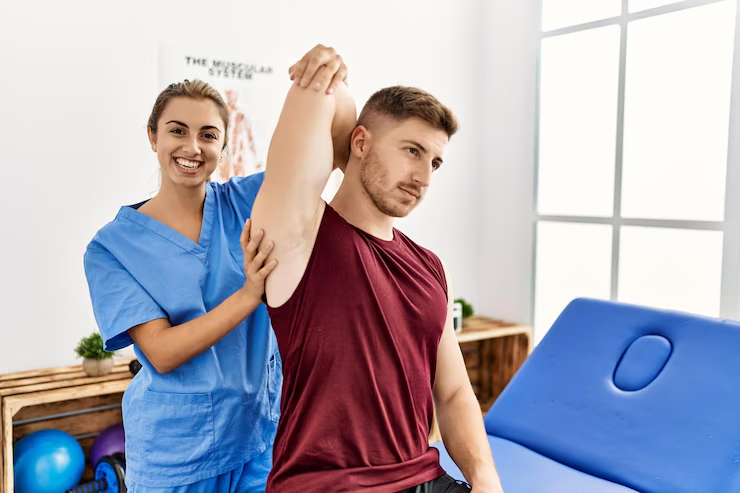
Ortho Rehabilitation
Ortho rehabilitation focuses on restoring mobility, strength, and function after orthopedic injuries or surgeries through personalized physiotherapy, exercises, and treatments to enhance recovery and prevent future issues.
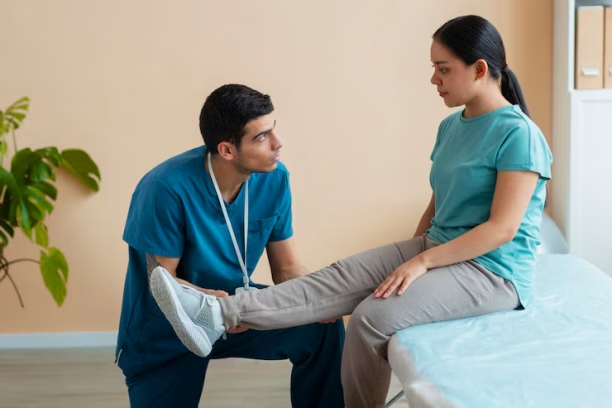
Neuro Rehabilition
Parkinson’s Disease is a progressive neurological disorder affecting movement, causing tremors, stiffness, and balance issues. It occurs due to dopamine deficiency in the brain and worsens over time, impacting daily activities and quality of life.
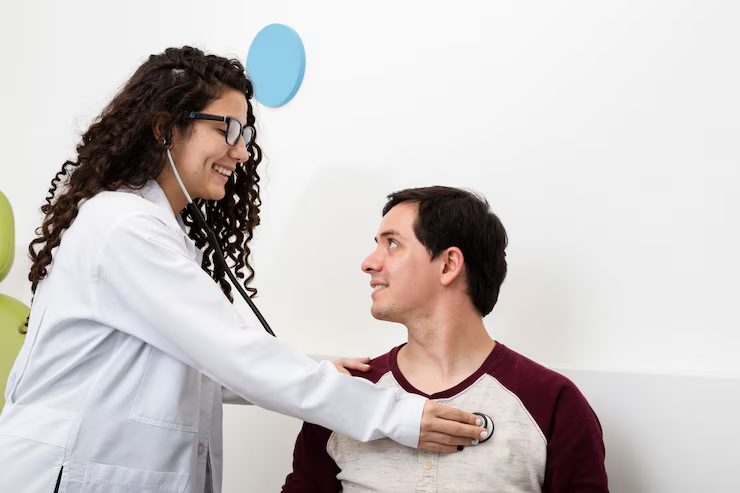
Cardio Rehabiliton
Cardio rehabilitation enhances heart health through supervised exercise, lifestyle modifications, and education, improving cardiovascular fitness, endurance, and overall well-being after heart-related events or surgeries.
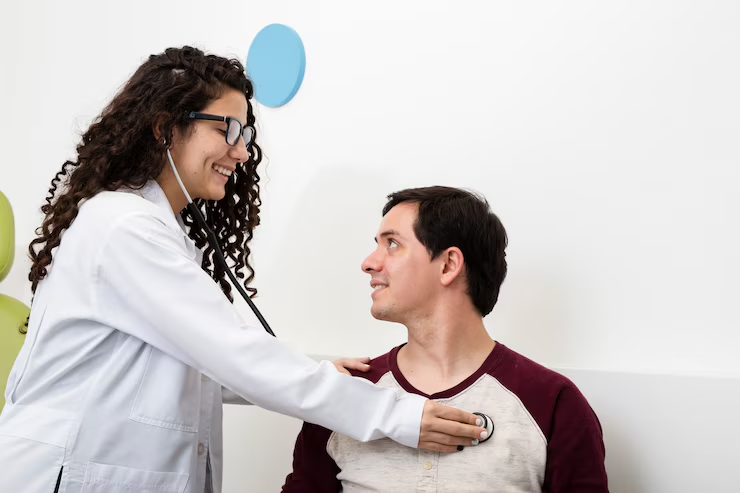
Pulmonary rehabilitation
Pulmonary rehabilitation improves lung function and breathing in patients with chronic respiratory conditions through exercise, education, and therapy, enhancing endurance, oxygen use, and quality of life.
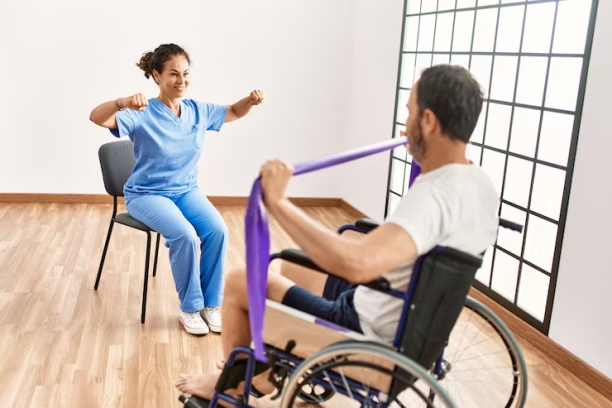
stroke rehabilitation
Stroke rehabilitation helps patients regain lost functions like movement, speech, and balance through personalized physiotherapy, promoting brain recovery, independence, and improved quality of life.
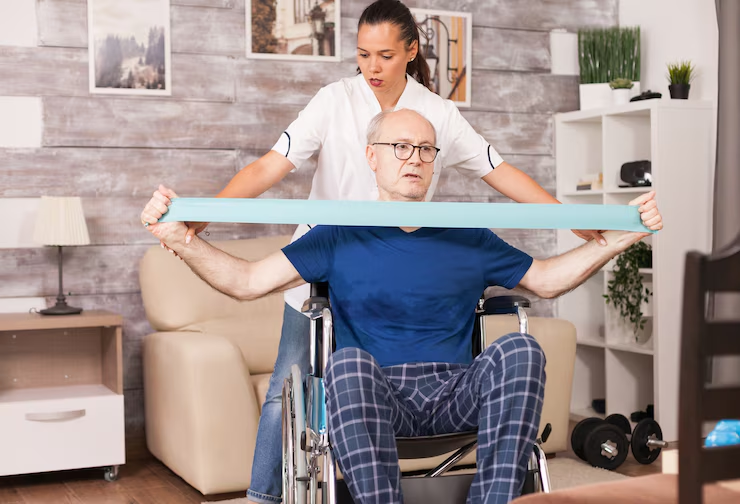
Spinal cord injury rehabilitation
Spinal cord injury rehabilitation aims to restore mobility, strength, and independence through targeted physiotherapy, functional training, and support, enhancing quality of life after injury.
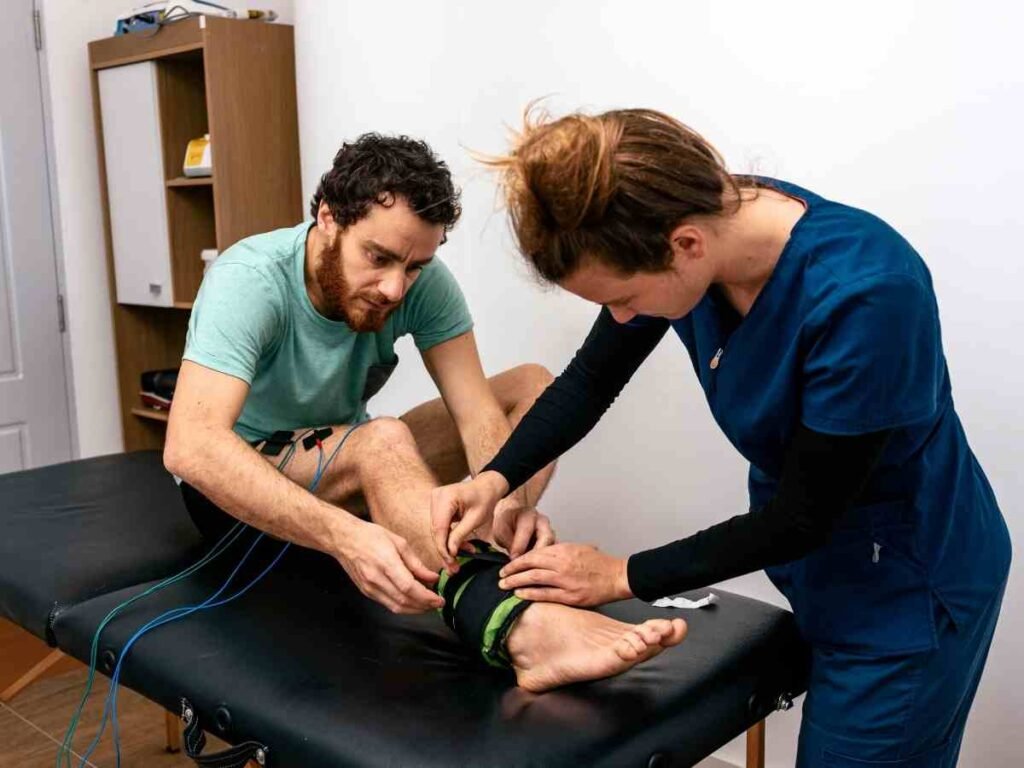
Pre and post Surgery
Pre and post-surgery rehabilitation prepares the body for surgery and aids recovery afterward through physiotherapy, improving strength, mobility, and healing for better surgical outcomes.
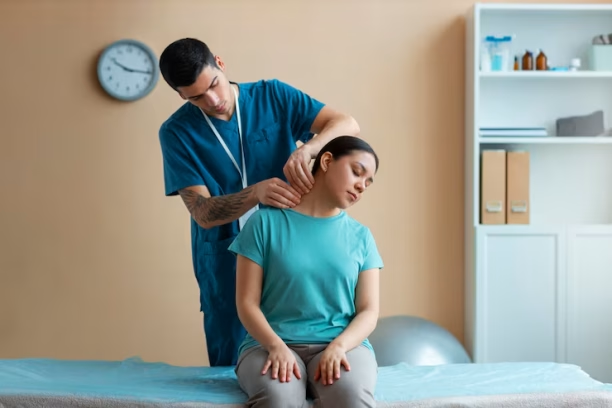
Dated physiotherapy
Dated physiotherapy refers to traditional or outdated techniques in physical therapy that may lack modern advancements, often replaced by evidence-based, effective, and patient-centered treatment approaches.
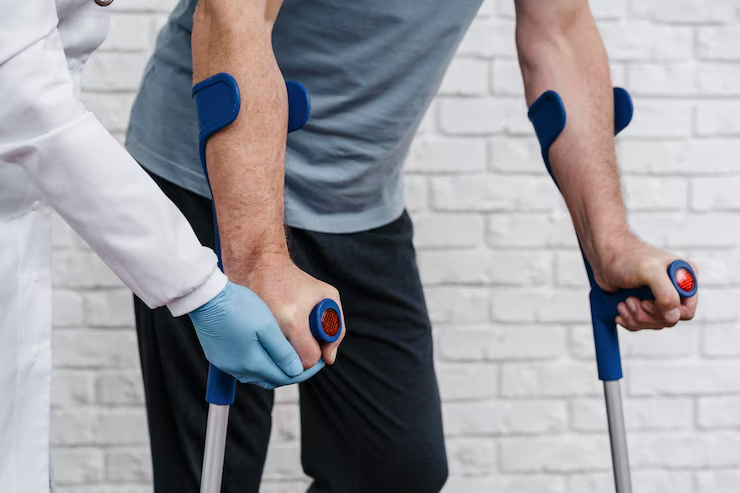
post surgery rehabilitation
Post-surgery rehabilitation focuses on restoring mobility, strength, and function after an operation through targeted physiotherapy, speeding up recovery and helping patients return to daily activities safely.
Ortho Rehabilitation
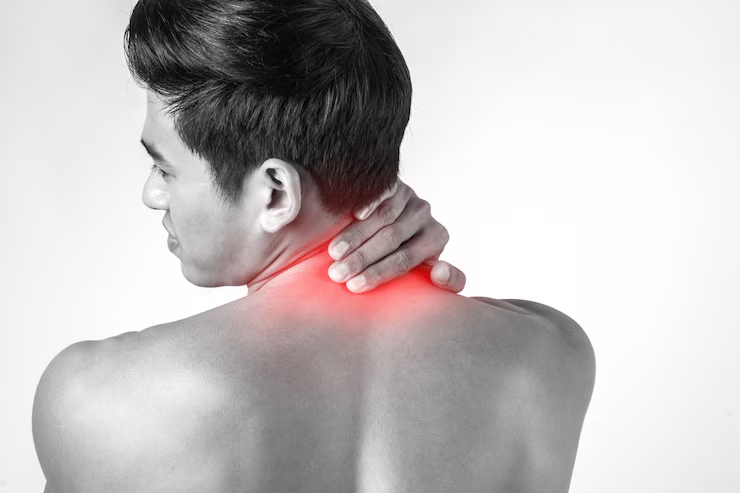
Neck Pain
Neck pain physiotherapy relieves stiffness, improves mobility, and reduces discomfort through targeted exercises, posture correction, and manual therapy for long-term relief and better quality of life.

Back Pain
Back pain physiotherapy helps reduce discomfort, improve posture, and restore mobility through exercises, manual therapy, and education, promoting long-term relief and a healthier spine.
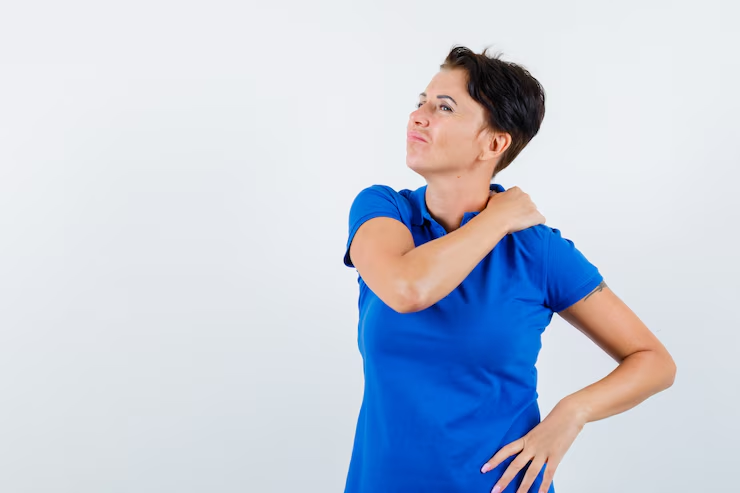
Shoulder Pain
Shoulder pain physiotherapy focuses on reducing inflammation, improving joint mobility, and strengthening muscles through targeted exercises and manual techniques for pain relief and functional recovery.

Knee Pain
Knee pain physiotherapy helps alleviate discomfort, improve joint mobility, and strengthen muscles through targeted exercises, manual therapy, and posture correction for long-term relief and functionality.
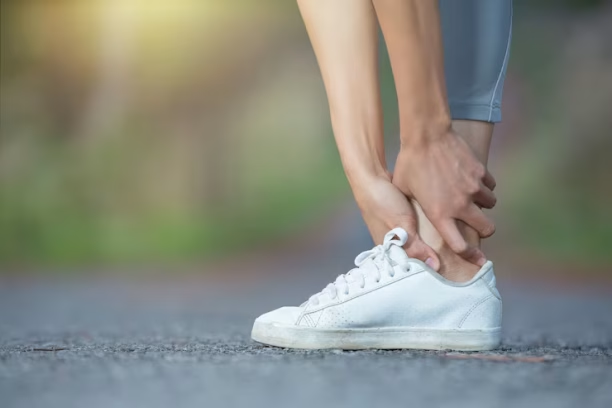
Ankle Pain
Ankle pain physiotherapy reduces inflammation, improves flexibility, and strengthens muscles through exercises and manual therapy, promoting healing, mobility, and preventing future injuries for long-term relief.
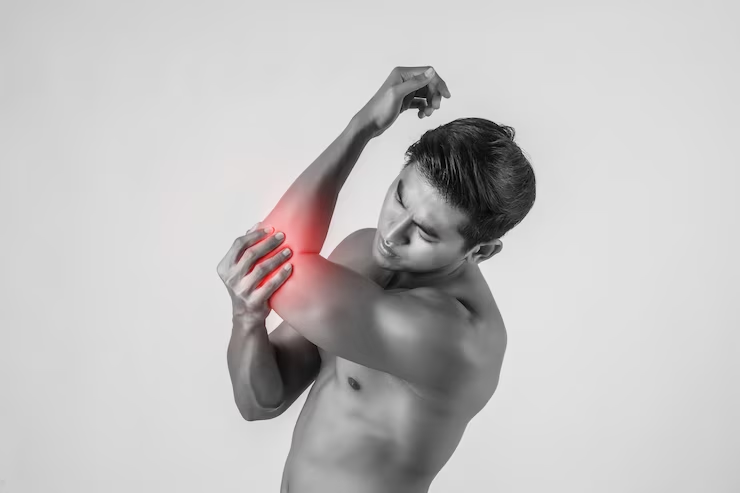
Elbow Pain
Elbow pain physiotherapy focuses on reducing inflammation, improving joint movement, and strengthening surrounding muscles through targeted exercises and manual therapy for pain relief and better function.
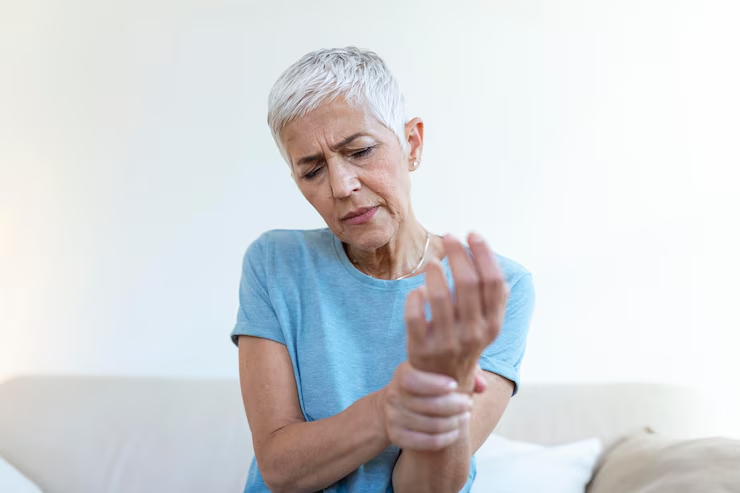
Joint Pain
Joint pain physiotherapy targets inflammation reduction, improves mobility, and strengthens muscles through exercises and manual therapy, promoting long-term relief and enhancing joint function and flexibility.
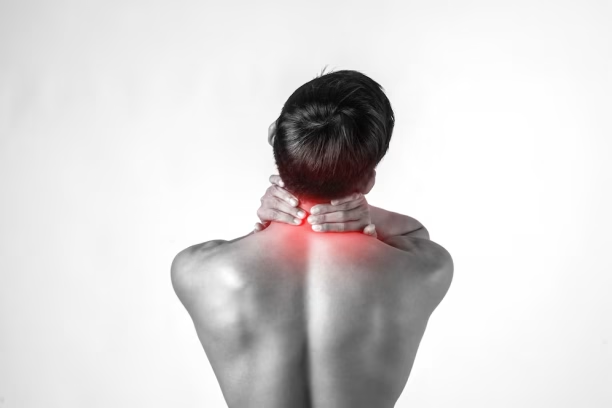
Cervical spondylosis
Cervical spondylosis physiotherapy focuses on relieving neck pain, improving mobility, and strengthening muscles through targeted exercises, posture correction, and manual therapy for long-term relief and comfort.

Lumbar spondylosis
Lumbar spondylosis physiotherapy targets lower back pain by improving mobility, reducing stiffness, and strengthening muscles through specific exercises and manual therapy for pain relief and function.

knee osteoarthritis
Knee osteoarthritis physiotherapy focuses on relieving pain, improving joint mobility, and strengthening muscles through targeted exercises, manual therapy, and posture correction for long-term joint function.
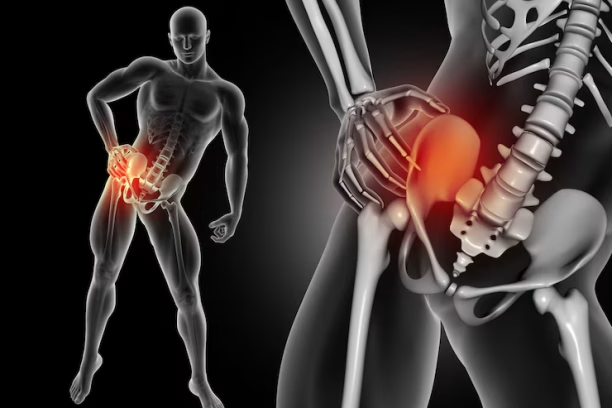
Hip Arthrosis
Hip arthrosis physiotherapy focuses on relieving pain, improving joint mobility, and strengthening muscles around the hip through targeted exercises and manual therapy for better function and comfort.

Lumbar spondylosis
Lumbar spondylosis physiotherapy targets lower back pain by improving mobility, reducing stiffness, and strengthening muscles through specific exercises and manual therapy for pain relief and function.

Frozen Shoulder
Frozen shoulder physiotherapy aims to reduce pain, improve range of motion, and restore shoulder function through stretching exercises, manual therapy, and strengthening techniques for long-term relief.
Pre and post-surgical rehabilitation
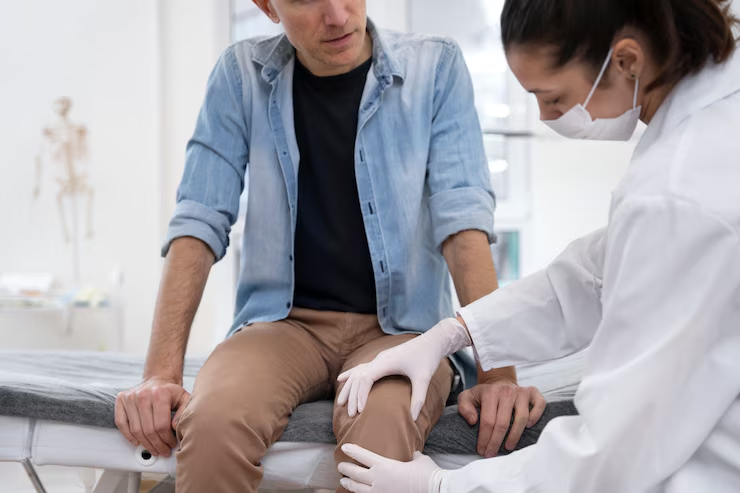
Total Knee Replacement
Total knee replacement physiotherapy focuses on restoring joint mobility, strengthening surrounding muscles, and improving function through targeted exercises, helping patients recover and regain independence after surgery.

Total Hip Replacement
Total hip replacement physiotherapy aids in restoring hip mobility, strengthening muscles, and improving function through targeted exercises, ensuring a smooth recovery and enhancing post-surgery quality of life.
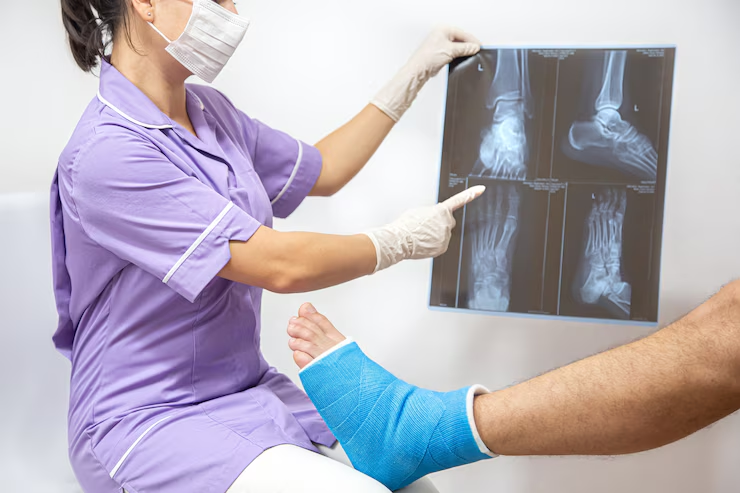
Post Fracture Case
Post-fracture physiotherapy promotes healing by improving mobility, strength, and flexibility through targeted exercises, manual therapy, and rehabilitation techniques, aiding recovery and preventing future injuries.

Normal Surgery Rehabilitation
Normal surgery rehabilitation focuses on restoring strength, mobility, and function through tailored physiotherapy exercises, improving recovery time, reducing pain, and helping patients return to daily activities.

Cancer Surgery Rehabilitation
Cancer surgery rehabilitation aids recovery by improving strength, mobility, and endurance through specialized physiotherapy, helping patients regain function, reduce pain, and enhance overall quality of life.

